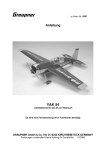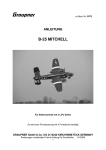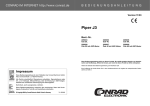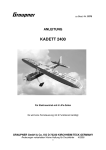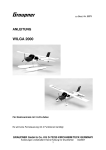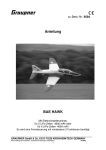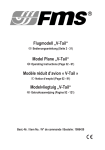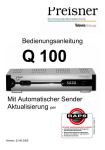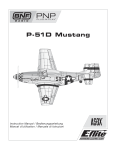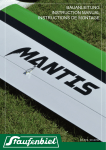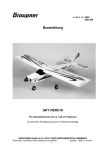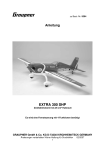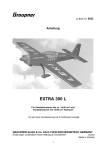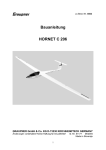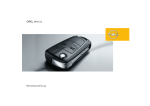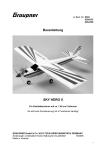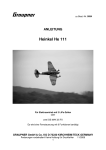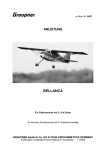Download KWIK FLY MK 3
Transcript
zu Best.-Nr. 9393 Anleitung KWIK FLY MK 3 Zweitaktmotoren mit 9,0 cm³ oder Viertaktmotoren mit 8,56 cm³ Hubraum Es wird eine Fernsteuerung mit 5 Funktionen benötigt GRAUPNER GmbH & Co. KG D-73230 KIRCHHEIM/TECK GERMANY Änderungen vorbehalten! Keine Haftung für Druckfehler 1 02/2007 Technische Daten Spannweite ca. Rumpflänge ohne Spinner ca. Flächeninhalt ca. Höhenleitwerksinhalt ca. Gesamtflächeninhalt ca. Fluggewicht je nach Ausrüstung ca. EWD Schwerpunkt 1510 mm 1280 mm 53 dm² 10,4 dm² 52,9 dm² 3065 g 0-0.5 Grad ca. 102 mm hinter der Nasenleiste Achtung: Dieses Modell ist kein Spielzeug! Sollten Sie mit solch motorisiertem Modell keine Erfahrung haben, wenden Sie sich bitte an erfahrene Modellflieger, die Sie unterstützen können. Es könnte zu Verletzungen kommen, wenn das Modell ohne Vorkenntnisse in Betrieb genommen wird. Denken Sie an die Sicherheit und Ihre Gesundheit. Wichtig! Bevor Sie mit dem Bau beginnen! Auch wenn Sie schon viele RC-Modelle gebaut haben, lesen Sie diese Anleitung genauestens durch und kontrollieren Sie die Teile dieses Bausatzes auf Vollständigkeit. Es wurde viel Mühe darauf verwand, den Aufwand möglichst einfach zu machen, ohne die Sicherheit zu beeinträchtigen. Hinweis zur Folienbespannung Auf Grund von starken Wetteränderungen (Temperatur, Feuchtigkeit etc.) können in der Bespannfolie kleine Falten auftreten. In seltenen Fällen auch ein Verzug der Bauteile. Dies liegt in der Natur der Holzbauweise mit Folienbespannung. Es kann, wie folgt, mit einem Heißluftgebläse (Fön), wie sie für den Modellbauer angeboten werden, wieder korrigiert werden. Falten: Mit Warmluft anblasen und mit weichem Tuch anreiben. Verzogene Fläche: Fläche dem Verzug entgegen leicht verdreht aufspannen und mit Warmluft die Bespannung wieder glätten. Vorsicht! Nicht mehr Wärme zuführen, als unbedingt notwendig. Bei zu heißem Bügeleisen schmilzt die Folie und es entstehen Löcher. Das weitgehend vorgefertigte Modell benötigt nur noch wenig Bauzeit. Aber die verbleibenden Arbeiten sind wichtig und müssen sorgfältig ausgeführt werden. Von deren einwandfreier Ausführung hängt es ab, ob das Modell letztlich die vorgesehene Festigkeit und Flugeigenschaften haben wird; deshalb langsam und präzise arbeiten! Wenn Blechschrauben in Holz eingeschraubt werden, diese durch Weißleim gegen Lösen sichern: Weißleim in Bohrung einspritzen und Schraube eindrehen. GRAUPNER GmbH & Co. KG D-73230 KIRCHHEIM/TECK GERMANY Änderungen vorbehalten! Keine Haftung für Druckfehler 2 02/2007 Sicherheitshinweise und Warnungen betreffend Motor-Flugmodelle mit Verbrennungsmotoren • • • • • • • • • • • • Vor dem Versuch der ersten Inbetriebnahme muss die gesamte Betriebsund Montageanleitung sorgfältig gelesen werden. Diese Sicherheitshinweise sind Bestandteil dieser Anleitung und müssen zusammen mit der Bedienungsanleitung sorgfältig aufbewahrt und im Falle einer Weitergabe dem nachfolgenden Benutzer unbedingt mit ausgehändigt werden. Motorflugmodelle sind sehr anspruchsvolle und gefährliche Gegenstände und erfordern vom Betreiber einen hohen Sachverstand, Können und Verantwortungsbewusstsein. Motorflugmodelle sind für Personen unter 18 Jahren nicht geeignet. Ein Betrieb darf nur unter Anleitung und Aufsicht eines Erwachsenen erfolgen, der mit den sich daraus ergebenden Gefahren vertraut ist. Der Betreiber muss im Besitz seiner vollen körperlichen und geistigen Fähigkeiten sein. Wie beim Autofahren, ist der Betrieb des Flugmodells unter Alkohol oder Drogeneinwirkung nicht erlaubt. Ferngesteuerte Flugmodelle dürfen nur für den vom Hersteller vorgesehenen Zweck eingesetzt werden, also als nicht manntragendes Sportgerät. Eine anderweitige Verwendung ist verboten. Ein Modell kann nur funktionstüchtig sein und den Erwartungen entsprechen, wenn es im Sinne der Bauanleitung sorgfältigst gebaut oder montiert wurde. Eigenmächtige Veränderungen von Konstruktion und Material sind nicht zulässig. Nur ein vorsichtiger und überlegter Umgang beim Betrieb schützt vor Personen- und Sachschäden. Niemand würde sich in ein Sportflugzeug setzen und - ohne vorausgegangene Schulung versuchen, damit zu fliegen. Auch Modellfliegen will gelernt sein! Bitte wenden Sie sich dazu an erfahrene Modellflieger, an Vereine oder Modellflugschulen. Ferner sei auf den Fachhandel und die einschlägige Fachpresse verwiesen. Unbedingt die Angaben zur Schwerpunktlage und zu Ruderausschlägen beachten! Das Modell muss entsprechend justiert werden. Fernlenkanlage: Sich vergewissern, dass die verwendete Frequenz frei ist. Erst dann einschalten! RC-Anlage öfters kontrollieren; auch sie ist gewissem Verschleiß ausgesetzt. Funkstörungen, verursacht durch Unbekannte, können stets ohne Vorwarnung auftreten! Das Modell ist dann steuerlos und unberechenbar! Fernlenkanlage nie unbeaufsichtigt lassen, um ein Betätigen durch Dritte zu verhindern. Immer auf vollgeladene Akkus achten, da sonst keine einwandfreie Funktion der RC-Anlage gewährleistet ist. Warnungen müssen unbedingt beachtet werden. Sie beziehen sich auf Dinge und Vorgänge, die bei einer Nichtbeachtung zu schweren - in Extremfällen tödlichen Verletzungen oder bleibenden Schäden führen können. Sie alleine sind verantwortlich für den sicheren Betrieb Ihres Modells und Motors. GRAUPNER GmbH & Co. KG D-73230 KIRCHHEIM/TECK GERMANY Änderungen vorbehalten! Keine Haftung für Druckfehler 3 02/2007 • • • • • • • • • • • • • • • Fragen, die die Sicherheit beim Betrieb von Modell und Motor betreffen, werden Ihnen vom Fachhandel gerne beantwortet. Luftschrauben und generell alle sich drehenden Teile, die durch einen Motor angetrieben werden, stellen eine ständige Verletzungsgefahr dar. Sie dürfen mit keinem Körperteil berührt werden! Eine schnell drehende Luftschraube kann z. B. einen Finger abschlagen! Sich niemals in der Drehebene von Luftschrauben aufhalten! Es könnte sich doch einmal ein Teil davon lösen und mit hoher Geschwindigkeit und viel Energie wegfliegen und Sie oder Dritte Personen treffen. Darauf achten, dass kein sonstiger Gegenstand mit einer laufenden Luftschraube in Berührung kommt! Vorsicht bei losen Kleidungsstücken wie Schals, weiten Hemden usw.: sie werden vom Propellerstrahl angesaugt und können in den Luftschraubenkreis gelangen. Informieren Sie alle Passanten und Zuschauer vor der Inbetriebnahme über alle möglichen Gefahren, die von Ihrem Modell ausgehen und ermahnen diese, sich in ausreichendem Schutzabstand (wenigstens 5 m) aufzuhalten. Modellflug darf nur bei "normalen" Außentemperaturen betrieben werden, d. h. in einem Bereich von - 5º C bis + 35º C. Extremere Temperaturen können zu Veränderungen von z. B. Akku-Kapazität und Werkstoffeigenschaften und anderem führen. Modellkraftstoff ist giftig! Nicht in Kontakt mit Augen oder Mund bringen! Eine Aufbewahrung ist nur in deutlich gekennzeichneten Behältern und außerhalb der Reichweite von Kindern zulässig. Motor nie in geschlossenen Räumen, wie Keller, Garage usw. laufen lassen. Auch Modellmotoren entwickeln tödliches Kohlenmonoxyd-Gas. Nur im Freien betreiben! Klebstoffe und Lacke enthalten Lösungsmittel, die unter Umständen gesundheitsschädlich sein können. Beachten Sie daher unbedingt auch die entsprechenden Hinweise und Warnungen der entsprechenden Hersteller. Modellkraftstoff ist leicht entzündlich und brennbar; fernhalten von offenem Feuer, übermäßiger Wärme, irgendwelchen Quellen von Funken oder sonstigen Dingen, die zu einer Entzündung führen können. In der direkten Umgebung von Kraftstoff oder Kraftstoffdämpfen darf nicht geraucht werden. Ein Modellmotor entwickelt beim Betrieb eine Menge Hitze. Motor und Schalldämpfer sind darum während des Betriebs und noch eine Weile danach sehr heiß. Bei Berührung kann das zu ernsthaften Verbrennungen führen. Vorsicht bei Einstellarbeiten! Schutzhandschuhe tragen! In Extremfällen können auch Brände ausgelöst werden. Während des Betriebs des Motors treten nicht nur giftige und heiße Abgase aus dem Auspuff aus, sondern auch sehr heiße und flüssige Verbrennungsrückstände, die zu Verbrennungen führen können. Nach dem Betrieb sind Kraftstoffreste aus Tank und Motor zu entfernen. Überprüfen Sie vor und nach jeder Inbetriebnahme das Modell und alle an ihm angekoppelten Teile (z. B. Luftschrauben, Ruderanlenkungen, Ruder usw.) auf mögliche Beschädigungen. Das Modell darf erst nach Beseitigung aller Mängel in Betrieb genommen werden. GRAUPNER GmbH & Co. KG D-73230 KIRCHHEIM/TECK GERMANY Änderungen vorbehalten! Keine Haftung für Druckfehler 4 02/2007 • • • • • • • • • • • • • • • • Das Anlassen des Motors erfolgt mit einem Elektrostarter, der evtl. mit einem zum Modell passenden Adapter ausgerüstet ist. Als alternative Anwerfhilfe bei Flächenmodellen kann z. B. ein Rundholz mit einem aufgesteckten Stück Wasserschlauch verwendet werden. Modellmotoren entwickeln im Betrieb u. U. einen Schallpegel der weit größer als 85 dB (A) sein kann, dabei unbedingt Gehörschutz tragen. Motoren nie ohne Schalldämpfer laufen lassen. Aber auch mit Schalldämpfer können Modellmotoren Nachbarn stören. Ruhezeiten beachten! Steht ein Modell mit drehender Luftschraube z. B. auf sandigem Grund, so wird Sand oder Staub angesaugt und herumgewirbelt, der auch ins Auge fliegen kann. Schutzbrille tragen! Darauf achten, dass weder der Glühkerzenstecker, noch das dazugehörige Kabel mit der sich drehenden Luftschraube oder anderen sich drehenden Teilen in Berührung kommt. Auch das Drosselgestänge daraufhin überprüfen. Besondere Vorsicht ist geboten, wenn das Modell mit laufendem Motor getragen wird. Drehende Teile dabei weit von sich weghalten! Stets auf ausreichende Kraftstoffmenge im Tank achten. Der Tankinhalt kann nie restlos ausgeflogen werden. Nie Personen überfliegen. Nie auf Personen zufliegen. Auf ausreichenden Abstand zu Wohngebieten achten, mindestens 1,5 km Luftlinie. Am besten als Club-Mitglied auf zugelassenem Modellflugplatz fliegen. Ausreichenden Abstand zu Hochspannungsleitungen halten. Beim Hantieren am Motor unbedingt auf gute Standfestigkeit achten, auch das Modell muss dabei gut festgehalten werden. Während des Start- und Landevorgangs müssen die Start- und Landeflächen frei von unbefugten Personen und beweglichen Hindernissen sein. Das Flugmodell muss während des gesamten Fluges ständig beobachtet werden können. Es hat bemannten Luftfahrzeugen stets auszuweichen. Betreiben Sie Ihr Modell nie auf öffentlichen Straßen, Plätzen, Schulhöfen, Park- oder Spielplätzen usw. und sorgen Sie dafür, dass Sie es stets unter voller Kontrolle haben. Um einen laufenden Motor jederzeit anhalten zu können, muss man die Drossel so eingestellt haben, dass das Vergaserküken ganz geschlossen wird, wenn Steuerknüppel und Trimmhebel in die Leerlaufendstellung gebracht werden. Geht dies nicht, wird die Kraftstoffzufuhr durch Abklemmen oder Abziehen des Verbindungsschlauches zum Tank unterbrochen. Niemals versuchen, den Motor am Schwungrad, Propeller oder Spinner anzuhalten! Jeder Modellflieger hat sich so zu verhalten, dass die öffentliche Sicherheit und Ordnung, insbesondere andere Personen und Sachen sowie die Ordnung des Modellflugbetriebs nicht gefährdet oder gestört wird. Rechtlich gesehen ist ein Flugmodell ein Luftfahrzeug und unterliegt entsprechenden Gesetzen, die unbedingt eingehalten werden müssen. GRAUPNER GmbH & Co. KG D-73230 KIRCHHEIM/TECK GERMANY Änderungen vorbehalten! Keine Haftung für Druckfehler 5 02/2007 • • • Die Broschüre »Modellflugrecht, Paragrafen und mehr«, Best.-Nr. 8034.01, stellt eine Zusammenfassung dieser Gesetze dar; sie kann auch beim Fachhandel eingesehen werden. Bei Modellen mit Verbrennungsmotoren muss z. B. eine Aufstiegserlaubnis vorliegen und es besteht Versicherungspflicht. Ferner müssen Auflagen, die die Fernlenkanlage betreffen, beachtet werden. Mit diesen Hinweisen soll auf die vielfältigen Gefahren hingewiesen werden, die durch unsachgemäße und verantwortungslose Handhabung entstehen können. Richtig und gewissenhaft betrieben ist Modellflug eine kreative, lehrreiche und erholsame Freizeitgestaltung. Das weitgehend vorgefertigte Modell benötigt nur noch wenig Bauzeit. Aber die verbleibenden Arbeiten sind wichtig und müssen sorgfältig ausgeführt werden. Von deren einwandfreier Ausführung hängt es ab, ob das Modell letztlich die vorgesehene Festigkeit und Flugeigenschaften haben wird; deshalb langsam und präzise arbeiten! Wichtige Sicherheitshinweise Sie haben einen Bausatz erworben, aus dem – zusammen mit entsprechendem geeigneten Zubehör – ein funktionsfähiges RC-Modell fertiggestellt werden kann. Die Einhaltung der Montage- und Betriebsanleitung im Zusammenhang mit dem Modell sowie die Installation, der Betrieb, die Verwendung und Wartung der mit dem Modell zusammenhängenden Komponenten können von GRAUPNER nicht überwacht werden. Daher übernimmt GRAUPNER keinerlei Haftung für Verluste, Schäden oder Kosten, die sich aus dem fehlerhaften Betrieb, aus fehlerhaftem Verhalten bzw. in irgendeiner Weise mit dem vorgenannten zusammenhängend ergeben. Soweit vom Gesetzgeber nicht zwingend vorgeschrieben, ist die Verpflichtung der Firma GRAUPNER zur Leistung von Schadensersatz, aus welchem Grund auch immer ausgeschlossen (inkl. Personenschäden, Tod, Beschädigung von Gebäuden sowie auch Schäden durch Umsatz- oder Geschäftsverlust, durch Geschäftsunterbrechung oder andere indirekte oder direkte Folgeschäden), die von dem Einsatz des Modells herrühren. Die Gesamthaftung ist unter allen Umständen und in jedem Fall beschränkt auf den Betrag, den Sie tatsächlich für dieses Modell gezahlt haben. Die Inbetriebnahme und der Betrieb des Modells erfolgt einzig und allein auf Gefahr des Betreibers. Nur ein vorsichtiger und überlegter Umgang beim Betrieb schützt vor Personen- und Sachschäden. Prüfen Sie vor dem ersten Einsatz des Modells, ob Ihre Privat-Haftpflichtversicherung den Betrieb von Modellen dieser Art mit einschließt. Schließen Sie gegebenenfalls eine spezielle RC-Modell-Haftpflichtversicherung ab. Diese Sicherheitshinweise müssen unbedingt aufbewahrt werden und müssen bei einem Weiterverkauf des Modells an den Käufer weitergegeben werden. Herstellererklärung: Sollten sich Mängel an Material oder Verarbeitung an einem von uns in der Bundesrepublik Deutschland vertriebenen, durch einen Verbraucher (§ 13 BGB) erworbenen Gegenstand zeigen, übernehmen wir, die Fa. Graupner GmbH & Co KG, GRAUPNER GmbH & Co. KG D-73230 KIRCHHEIM/TECK GERMANY Änderungen vorbehalten! Keine Haftung für Druckfehler 6 02/2007 Henriettenstraße 94-96 D-73230 Kirchheim/Teck im nachstehenden Umfang die Mängelbeseitigung für den Gegenstand. Rechte aus dieser Herstellererklärung kann der Verbraucher nicht geltend machen, wenn die Beeinträchtigung der Brauchbarkeit des Gegenstandes auf natürlicher Abnutzung, Einsatz unter Wettbewerbsbedingungen, unsachgemäßer Verwendung (einschließlich Einbau) oder Einwirkung von außen beruht. Diese Herstellererklärung lässt die gesetzlichen oder vertraglich eingeräumten Mängelansprüche und –rechte des Verbrauchers aus dem Kaufvertrag gegenüber seinem Verkäufer (Händler) unberührt. Umfang der Garantieleistung Im Garantiefall leisten wir nach unserer Wahl Reparatur oder Ersatz der mangelbehafteten Ware. Weitergehende Ansprüche, insbesondere Ansprüche auf Erstattung von Kosten im Zusammenhang mit dem Mangel (z.B. Ein-/Ausbaukosten) und der Ersatz von Folgeschäden sind – soweit gesetzlich zugelassen – ausgeschlossen. Ansprüche aus gesetzlichen Regelungen, insbesondere nach dem Produkthaftungsgesetz, werden hierdurch nicht berührt. Voraussetzung der Garantieleistung Der Käufer hat den Garantieanspruch schriftlich unter Beifügung des Originals des Kaufbelegs (z.B. Rechnung, Quittung, Lieferschein) und dieser Garantiekarte geltend zu machen. Er hat zudem die defekte Ware auf seine Kosten an die o.g. Adresse einzusenden. Der Käufer soll dabei den Material- oder Verarbeitungsfehler oder die Symptome des Fehlers so konkret benennen, dass eine Überprüfung unserer Garantiepflicht möglich wird. Der Transport des Gegenstandes vom Verbraucher zu uns als auch der Rücktransport erfolgen auf Gefahr des Verbrauchers. Gültigkeitsdauer Diese Erklärung ist nur für während der Anspruchsfrist bei uns geltend gemachten Ansprüche aus dieser Erklärung gültig. Die Anspruchsfrist beträgt 24 Monate ab Kauf des Gerätes durch den Verbraucher bei einem Händler in der Bundesrepublik Deutschland (Kaufdatum). Werden Mängel nach Ablauf der Anspruchsfrist angezeigt oder die zur Geltendmachung von Mängeln nach dieser Erklärung geforderten Nachweise oder Dokumente erst nach Ablauf der Anspruchsfrist vorgelegt, so stehen dem Käufer keine Rechte oder Ansprüche aus dieser Erklärung zu. Verjährung Soweit wir einen innerhalb der Anspruchsfrist ordnungsgemäß geltend gemachten Anspruch aus dieser Erklärung nicht anerkenne, verjähren sämtliche Ansprüche aus dieser Erklärung in 6 Monaten vom Zeitpunkt der Geltendmachung an, jedoch nicht vor Ende der Anspruchsfrist. Anwendbares Recht GRAUPNER GmbH & Co. KG D-73230 KIRCHHEIM/TECK GERMANY Änderungen vorbehalten! Keine Haftung für Druckfehler 7 02/2007 Auf diese Erklärung und die sich daraus ergebenden Ansprüche, Rechte und Pflichten findet ausschließlich das materielle deutsche Recht ohne die Normen des Internationalen Privatrechts sowie unter Ausschluss des UN-Kaufrechts Anwendung. Folgende Punkte müssen unbedingt beachtet werden: • Kontrollieren Sie, bevor Sie das Modell starten, dieses auf eine sichere Funktion der Fernsteuerung sowie die Steckverbindungen auf sichere und feste Verbindung. • Sollten Trockenbatterien zur Stromversorgung verwendet werden, dürfen diese niemals nachgeladen werden. Nur Akkus dürfen nachgeladen werden. • Die Akkus müssen geladen sein und die Reichweite der Fernsteuerung muss überprüft worden sein. Besonders die Sender- und Empfängerakkus müssen vor jedem Start geladen werden. • Prüfen Sie, ob der von Ihnen genutzte Kanal frei ist. Fliegen Sie niemals, wenn Sie sich nicht sicher sind, ob der Kanal frei ist. • Beachten Sie die Empfehlungen und Hinweise zu Ihrer Fernsteuerung und Zubehörteilen. • Achten Sie darauf, dass die Servos in ihrem Verfahrweg mechanisch nicht begrenzt werden. • Batterien und Akkus dürfen nicht kurzgeschlossen werden. • Entnehmen Sie die Akkus bei Transport und Nichtgebrauch des Modells. • Setzen Sie das Modell nicht starker Luftfeuchtigkeit, Hitze, Kälte sowie Schmutz aus. • Sichern Sie das Modell und RC-Komponenten beim Transport gegen Beschädigung sowie Verrutschen. Überprüfung vor dem Start Vor jedem Einsatz korrekte Funktion und Reichweite überprüfen. Dazu Senderantenne einschrauben und dann auf vollständige Länge ausziehen. Dann den Sender einschalten, ebenso den Empfänger. Aus entsprechendem Abstand vom Modell kontrollieren, ob alle Ruder einwandfrei funktionieren und in der richtigen Richtung ausschlagen. Diese Überprüfung bei laufendem Motor wiederholen, während ein Helfer das Modell festhält. Beim erstmaligen Steuern eines Flugmodells ist es von Vorteil, wenn ein erfahrener Helfer bei der Überprüfung und den ersten Flügen zur Seite steht. Pflege und Wartung • Säubern Sie das Modell nach jedem Gebrauch. Entfernen Sie Schmutzreste auch vom Propeller. Säubern Sie das Modell und die RC-Komponenten nur mit geeigneten Reinigungsmitteln. Informieren Sie sich hierzu bei Ihrem Fachhändler. • Wenn das Modell längere Zeit nicht betrieben werden soll, müssen alle bewegten Teile gesäubert und neu geschmiert werden. GRAUPNER GmbH & Co. KG D-73230 KIRCHHEIM/TECK GERMANY Änderungen vorbehalten! Keine Haftung für Druckfehler 8 02/2007 Hinweise zum Bau des Modells • Vor dem Bau des Modells sollte man unbedingt den Bauplan und die Anleitung bis zum Schluss lesen. Die Stückliste ist als Hilfsmittel zu benutzen. Anleitung und Stückliste sind in Reihenfolge des Zusammenbaus gehalten. • Achten Sie beim Einsatz von Werkzeugen auf die möglichen Gefahren. • Verwenden Sie nur geeignete Kabel, die den im Betrieb auftretenden Stromstärken genügen. • Verlegen Sie die Empfangsantenne möglichst weit entfernt von den Fahrstrom leitenden Kabeln (mindestens 3 cm). • Säubern Sie jede Klebeverbindung von Fettresten, bevor Sie diese verkleben. Dies kann z. B. durch Anschleifen und mit einem nicht nachfettenden Spülmittel geschehen. Das gleiche gilt für die zu lackierenden Oberflächen um eine gute Haltbarkeit der Farbe zu erreichen. Vor dem Festkleben von Teilen, unbedingt die entsprechenden Flächen (besonders bei GFK-Rümpfen) sorgfältig mit feinem Schleifpapier aufrauen und gründlich mit z. B. Aceton entfetten. Sonst ist keine ausreichende Verklebung gewährleistet. Zusätzlich benötigtes Zubehör Motor und Zubehör Motor Best.-Nr. OS MAX 46 AX 2701 OS MAX 46 Fxi 2702 OS MAX 50 SX 1933 OS MAX 55 AX 2715 Viertaktmotor OS MAX FS 52 SURPASS 1874 Hubraum Cm³ 7,45 Schalldämpfer Best.-Nr. 2701.33 7,45 2701.33 8,12 1809.33 oder 1871.72 2715.33 9,0 8,56 1874.33 oder 1411.33 Luftschraube Best.-Nr. 28x15 cm 1316.28.15 28x15 cm 1316.28.15 32x15 cm 1316.32.15 33x18 cm 1318.33.18 30x15 cm 1316.30.15 Glühkerze Best.-Nr. 1682 1682 1682 1682 1680 Fernlenkanlage Sie muss über mindestens 5 Steuerfunktionen und 6 Servos verfügen. Ferner sollte am Sender eine Servo-Drehrichtungsumkehr möglich sein. Besonders empfohlen: Computer-System mx-12 bis mc-24. Es können Servos mit Normalabmessungen eingebaut werden. Als Empfängerakku empfehlen wir: GRAUPNER 4-2000 NIMH Best.-Nr.3415, welcher vor und nach dem Flugbetrieb stets gut gewartet werden muss, d. h., bis GRAUPNER GmbH & Co. KG D-73230 KIRCHHEIM/TECK GERMANY Änderungen vorbehalten! Keine Haftung für Druckfehler 9 02/2007 zum Erreichen der angegebenen Kapazität muss der Akku mehrmals geladen und wieder entladen werden. Für die Verbindung der beiden Querruder-Servos mit dem Empfänger werden zwei Entstörfilter, Best.-Nr. 1040 oder ein Klapp-Ferritkern, Best.-Nr. 98516 mit zwei Verlängerungskabeln Best.-Nr. 3935.11 benötigt. Die beiden Querruderservokabel müssen mit jeweils einem Verlängerungskabel Best.-Nr. 3935.32 verlängert werden. Schaumgummi zur Lagerung von Empfänger und Batterie, enthalten. Als Servos können solche mit Standardgröße eingebaut werden. Klebstoffe Epoxydkleber, z. B. UHU plus schnellfest, Best.-Nr. 962 Epoxydkleber, z. B. UHU plus endfest 300, Best.-Nr. 950 Weißleim, z. B. UHU coll, Best.-Nr. 958.60 UHU hart, z. B. Best.-Nr. 534 Sekundenkleber, z. B. Best.-Nr. 5821 Schraubensicherungslack, z. B. Best.-Nr. 952 Zubehör für den Betrieb (nicht enthalten) Kraftstoff mit synthetischem Öl, je nach verwendetem Motor Kraftstofffilter, z. B. Best.-Nr. 1650.1 Kraftstoffschlauch, z. B. Best.-Nr. 1643 Kraftstoffhandpumpe, z. B. Best.-Nr. 1610 oder 6870 Glühkerzenbatterie mit Kerzenstecker, z. B. Best.-Nr. 3248 Elektrostarter, z. B. Best.-Nr. 1628 Starterbatterie, z. B. Best.-Nr. 2592 Erforderliches Werkzeug (nicht enthalten) Verschiedene (Kreuzschlitz-) Schraubendreher, spitze Zange, Flachzange, Seitenschneider, Balsamesser oder Rasierklinge, verschiedene Bohrer, Universalkerzenschlüssel, Bleistift, Filzstift, Lötkolben mit feiner Spitze, Abkröpfzange Best.-Nr. 5732 GRAUPNER GmbH & Co. KG D-73230 KIRCHHEIM/TECK GERMANY Änderungen vorbehalten! Keine Haftung für Druckfehler 10 02/2007 Der Zusammenbau der KWIK FLY MK 3 Beginnen Sie erst mit dem Zusammenbau, wenn Sie sich mit den Bauteilen und einzelnen Baustadien vertraut gemacht haben. Sollte ein Bauteil Grund zur Beanstandung geben, so ist die vor Baubeginn Ihrem Fachhändler mitzuteilen. Mit den Fingern die Schlitze zur Aufnahme der Leitwerke im Rumpf und die Aussparung für die Fahrwerke in den Tragflügelhälften ertasten und mit einem heißen Lötkolben herausschmelzen. Höhen- und Seitenleitwerk in die Aufnahmeschlitze stecken und ausrichten. Rumpfkontur auf Seiten- und Höhenflosse übertragen, und mittels eines heißen GRAUPNER GmbH & Co. KG D-73230 KIRCHHEIM/TECK GERMANY Änderungen vorbehalten! Keine Haftung für Druckfehler 11 02/2007 Lötkolbens etwas kleiner als angezeichnet entlang an einem Stahllineal entlang durchschmelzen und vom Bauteil ablösen. Unter Zugabe von Klebstoff die Leitwerke in die Aufnahmeschlitz kleben. Wie zuvor ausrichten und bis zum Aushärten des Klebstoffes gegen Verrutschen sichern. Servos mittels Empfanganlage in Mittelstellung bringen. Servo an die Befestigungsklötzchen, mit den den Servos beiliegenden Schrauben, befestigen. Hierzu die Gummitüllen mit den Messinghohlnieten, Bund nach unten, in die Servoflansche stecken. Zum Vorbohren, Ø 1,5 mm, für die Schrauben können die Hohlnieten als Bohrschablone verwendet werden. Zum leichteren Einschieben können die Hohlnieten auf einen passenden Schraubendreher aufgefädelt werden. GRAUPNER GmbH & Co. KG D-73230 KIRCHHEIM/TECK GERMANY Änderungen vorbehalten! Keine Haftung für Druckfehler 12 02/2007 Die Servokabel jeweils mit einem Verlängerungskabel Best.-Nr. 3935.32 verlängern und die Steckverbindung gegen Lösen sichern, z. B. durch ein Stück Schrumpfschlauch oder mittels einem Tropfen Sekundenkleber. Jetzt werden die Servokabel mit einem Faden in die Tragflächenhälften eingezogen. Kurz hinter dem Stecker den Faden an das Kabel anbinden und in die Tragflächenhälfte einziehen, so dass sie aus der Bohrung neben der Wurzelrippe herauskommen Zum Anschrauben der Servoloks müssen in diese an den Ecken Befestigungslöcher gebohrt werden. GRAUPNER GmbH & Co. KG D-73230 KIRCHHEIM/TECK GERMANY Änderungen vorbehalten! Keine Haftung für Druckfehler 13 02/2007 Wie auf dem Foto zu sehen die Servos in den Tragflächenhälften befestigen. Die beiden Tragflächenhälften können zusammengeklebt oder nur mittels dem Aluminiumrohr zusammengesteckt werden. Bei zweiterrem besteht die Möglichkeit den Tragflügel für den Transport zu teilen. Beim zusammenkleben der Tragflügelhälften an einer Wurzelrippe Klebstoff auftragen um die beiden Tragflächenhälften zusammenkleben zu können. Wie auf dem Foto zu sehen, die beiden Tragflügelhälften mittels dem Aluminiumrohr zusammenstecken und bis zum Trocknen des Klebstoffes mit Klebestreifen gegen verdrehen sichern. Nach dem Trocknen des Klebstoffes die Löcher zum Einkleben der Ruderhornbuchsen in die Querruder bohren. Hierzu das Querrudergestänge, mit dem Gabelkopf, in den Servohebel einhängen um die Bohrungsmitte genau anzeichnen zu können. GRAUPNER GmbH & Co. KG D-73230 KIRCHHEIM/TECK GERMANY Änderungen vorbehalten! Keine Haftung für Druckfehler 14 02/2007 Damit nicht, aus versehen, das Ruder ganz durchgebohrt wird sollte wie auf dem Foto zu sehen auf den Bohrer ein entsprechender Stellring montiert werden, als Tiefenanschlag. In der Größe der Auflagefläche die Bespannfolie von den Rudern ablösen. Jetzt kann wie auf dem Foto zu sehen die Buchse/Ruderhorn eingeklebt werden. Die Anlenklasche sollte mit ca. 23 mm Hebelarm auf die M3 Schraube aufgedreht sein. Nach dem Trocknen des Klebstoffes, Gabelkopf in Servohebel einhängen, die Länge der Gestänge anzeichnen und mit der Zange Best.-Nr. 5732 z-förmig abbiegen. Gabelkopf aushängen, Gestänge in Anlenklasche, und Gabelkopf wieder in Servohebel einhängen. Es besteht die Möglichkeit das Modell mit starrem oder mit einem Einziehfahrwerk auszurüsten. Für den Einbau des starren Fahrwerks müssen die Fahrwerksdrähte in die beiliegenden Holzteile gesteckt werden. Wie auf dem Foto zu sehen die Aluminiumplatte an die Holzteile schrauben und diese wiederum an den Tragflügel. GRAUPNER GmbH & Co. KG D-73230 KIRCHHEIM/TECK GERMANY Änderungen vorbehalten! Keine Haftung für Druckfehler 15 02/2007 Für den Einbau des pneumatischen Hauptfahrwerks müssen an dieses zuerst die Luftleitungen angeschlossen werden. Von dem beiliegenden Schlauch zwei Stücke ca. 180 mm lang abschneiden und auf den Anschlussnippel der Mechanik stecken. Kunststoffabdeckungen beschneiden, einpassen und einkleben. GRAUPNER GmbH & Co. KG D-73230 KIRCHHEIM/TECK GERMANY Änderungen vorbehalten! Keine Haftung für Druckfehler 16 02/2007 Jetzt die Fahrwerke in die Aussparung in den Tragflächen legen und die Befestigungsbohrungen anbringen und Fahrwerke anschrauben. Federbeine in die Mechaniken stecken und so festklemmen, dass die Federwicklungen nach hinten zeigen. Jetzt die Radachsen mit aufgeschobenen Rädern auf die Federbeine stecken, so dass sie im eingefahrenen Zustand genau in der Mitte der Kunststoffschale liegen. Länge der Federbeine anzeichnen, Überstehendes abschneiden und für den Gewindestift, zum Festklemmen der Achsen, eine Fläche an die Federbeine schleifen bzw. feilen. Dabei darauf achten, dass die Räder parallel zur Längsachse des Modells montiert werden. Die Steuerkreuze für Höhenruder und Motordrossel wie abgebildet richten und auf die Servo montieren. Der Gestängeanschluss muss sich ohne merkliches Spiel drehen lassen. Höhenruder Motordrossel GRAUPNER GmbH & Co. KG D-73230 KIRCHHEIM/TECK GERMANY Änderungen vorbehalten! Keine Haftung für Druckfehler 17 02/2007 Servos für Seiten- Höhenruder und Motordrossel in das Servobrettchen montieren. Dabei darauf achten, dass die Servos sich in Mittelstellung befinden. Beim Einbau eines Einziehfahrwerks entsprechend der Mechanik die Beplankung ausschneiden. Mechanik vom Bugfahrwerk in die Aussparung im Rumpf stecken, Befestigungslöcher übertragen vorbohren und Mechanik festschrauben. Wie auf dem Foto zu sehen das Federbein montieren. Auch hier muss das Federbein, damit sich die Achse nicht verdrehen kann angeschliffen werden. GRAUPNER GmbH & Co. KG D-73230 KIRCHHEIM/TECK GERMANY Änderungen vorbehalten! Keine Haftung für Druckfehler 18 02/2007 Die Anlenkung des Bugfahrwerks erfolgt wie auf dem Foto zu sehen mittels zweier Stahlseile. Durch das Aufschrauben von jeweils einer Mutter auf die Augenschrauben ist eine Längenjustierung möglich. Beim Einbau eines starren Fahrwerks wird der Lagerbock mittels vier Zylinderblechschrauben an den Kopfspant geschraubt. Anlenkgestänge, mit der Doppelabkröpfung, in Anlenkhebel einhängen, Gestänge in Führungsrohr schieben und Anlenkhebel festklemmen. Das Anlenkgestänge wird am Servohebel mittels eines Gestängeanschlusses festgeklemmt. Die beiden Höhenrudergestänge werden mittels eines Duo-Gestängeanschlusses zusammengefasst. Nach den Maßangaben und in Verlängerung der Gestänge die Löcher zur Aufnahme der Ruderhörner in Seiten- und Höhenruder Löcher mit Ø 6 mm bohren. GRAUPNER GmbH & Co. KG D-73230 KIRCHHEIM/TECK GERMANY Änderungen vorbehalten! Keine Haftung für Druckfehler 19 02/2007 In der Größe der Auflagefläche die Bespannfolie von den Rudern ablösen. Bei den beiden Höhenrudern von oben, bei dem Seitenruder von rechts die Ruderhornbuchse in die Ruder kleben. Nach dem Trocknen des Klebstoffes die Gewindestange, Mutter und Anlenklasche aufdrehen. Nach dem Trocknen des Klebstoffes Gabelköpfe in die Anlenklaschen einhängen. Entsprechend dem Foto die Gestänge an den Servos anschließen. GRAUPNER GmbH & Co. KG D-73230 KIRCHHEIM/TECK GERMANY Änderungen vorbehalten! Keine Haftung für Druckfehler 20 02/2007 Wie auf dem Foto zu sehen den Tank zusammenbauen. Auf das Tankpendel ein Stück Silikonschlauch aufschieben. Dass freie Ende des Silikonschlauches auf das gerade Röhrchen des Tankverschlusses soweit schieben, dass, wenn später der Tankverschluss montiert ist, sich das Pendel im Tank ohne anzuecken bewegen kann. Die freien Kunststoffröhrchen mit einem Fön oder Feuerzeug leicht erwärmen, so dass man sie leicht biegen kann. Ein Röhrchen zeigt dann nach unten und ist später zum Befüllen des Tankes vorgesehen, das zweite zeigt nach oben, ist später die Entlüftung und der Überlauf beim Betanken. Die beiden Röhrchen jeweils mit einem Stück Silikonschlauch soweit verlängern, dass sie bis oben/unten reichen. Jetzt den Tankverschluss über den Stutzen am Tank schieben und mittels der Kreuzschlitzschraube festklemmen. Hierbei ist es wichtig, dass die Schraube soweit angezogen wird, dass der Tank dicht ist. Dies kann durch unter Wasser halten des Tankes kontrolliert werden. Den Tank unter Wasser halten Luft hineinblasen. Wenn der Tank dicht ist, dürfen jetzt keine Luftblasen aufsteigen. Auf jedes Röhrchen, welches aus dem Tank herauskommt, ein Stück Silikonschlauch, stecken zur Durchführung im Kopfspant. Die Silikonschläuche mit einem Filzstift kennzeichnen, welcher zum Motor, Überlauf und zum Betanken ist. Jetzt den Tank von der Tragflächenauflage aus so in den Rumpf schieben, dass die drei Silikonschläuche durch die Bohrung im Kopfspant kommen. Hierzu muss das Rc- GRAUPNER GmbH & Co. KG D-73230 KIRCHHEIM/TECK GERMANY Änderungen vorbehalten! Keine Haftung für Druckfehler 21 02/2007 Montagebrettchen aus dem Rumpf genommen werden. Nach dem Einschieben des Tanks wird es dann wieder in den Rumpf montiert Motorträger mit den beiliegenden Schrauben und Muttern an den Kopfspant schrauben. Den Motor so auf die Trägerarme des Motorträgers schrauben, dass zwischen Kopfspant und Spinnergrundplatte ca. 100 mm Abstand bleibt. Auf die Rumpfseiten jeweils einen Klebestreifen anbringen und wie auf dem Foto zu sehen, parallel zum Kopfspant ca. 25 mm eine Linie ziehen. Beim Justieren des Drosselgestänges darauf achten, dass bei Servo in Mittelstellung der Vergaser des Motors halb geöffnet, und bei Steuerknüppel und Trimmung ganz hinten der Vergaser geschlossen ist. Der Weg des Servos muss so eingestellt werden, dass es in beiden Endstellungen nicht mechanisch begrenzt wird. Die Motorhaube wird soweit über den Rumpf geschoben, dass zwischen Motorhaubenvorderkante und Spinnergrundplatte ein praller Spalt von ca. 1 mm bleibt. Motorhaube so zur Spinnergrundplatte ausrichten, dass die Anformung und die Grundplatte übereinstimmen, keinen Versatz zu einander haben. In dieser Position die Befestigungslöcher, auf jeder Seite zwei Stück, für die Motorhaube bohren, so dass sie genau in die Mitte der Materialstärke des GRAUPNER GmbH & Co. KG D-73230 KIRCHHEIM/TECK GERMANY Änderungen vorbehalten! Keine Haftung für Druckfehler 22 02/2007 Kopfspantes kommen. Die Positionen errechnen sich aus 25 mm minus halbe Materialstärke des Kopfspantes. Wie auf dem Foto zu sehen den Drucktank, Betätigungsservo, für Ventil, etc. einbauen. Zusammenbau der KWIK FLY MK 3 Für den Anschluss der beiden Querruderservos an den Empfänger empfiehlt es sich, in die entsprechenden Empfängerbuchsen (2 und 5) je ein 100 mm langes Verlängerungskabel einzustecken. Querruderservos an den Verlängerungskabeln, Luftleitung des Einziehfahrwerks anschließen, Tragflügel mit den beiden Dübeln in die Löcher des Spantes stecken und mittels der beiden Kunststoffschrauben auf dem Rumpf befestigen. Schrauben nur so fest anziehen, bis die Tragflächen unverrückbar auf dem Rumpf aufliegen. Auswiegen der KWIK FLY MK 3 Das Modell rechts und links neben dem Rumpf, ca. 102 mm hinter der Tragflächennasenleiste unterstützen. Bei korrekter Schwerpunktlage sollte das Modell sich waagerecht auspendeln, bzw. die Rumpfnase leicht nach unten zeigen. Falls erforderlich, muss der Schwerpunkt durch Verschieben des Antriebsakkus oder Ankleben von Blei erreicht werden. Vor dem Erstflug müssen sämtliche Ruder, bei Sendertrimmung in Mitte, genau auf Mittelstellung (Nullstellung) gebracht werden. GRAUPNER GmbH & Co. KG D-73230 KIRCHHEIM/TECK GERMANY Änderungen vorbehalten! Keine Haftung für Druckfehler 23 02/2007 Ruderausschläge für Normalflug Querruder nach oben und unten 30mm Höhenruder nach oben und unten 40 mm Seitenruder nach rechts und links 70 mm Es empfiehlt sich, senderseitig Exponentialwerte von 50 % einzustellen. Wichtig: Bei der Montage der Gestänge grundsätzlich sorgfältig darauf achten, dass diese leicht laufen, ihren vollen steuerbaren Weg - einschließlich Trimmung - ausführen können und keinesfalls mechanisch begrenzt werden. Beim Bewegen des Steuerknüppels nach rechts, muss das Seitenruder nach rechts ausschlagen (links/links). Beim Bewegen des Höhen-/Tiefenruder-Knüppels nach hinten, sprich zum Bauch, müssen die Ruder nach oben ausschlagen (vorne = nach unten). Beim Bewegen des Querruder-Steuerknüppels nach rechts, muss das rechte Querruder nach oben, das linke nach unten ausschlagen. Beim Bewegen des Gasknüppels nach vorne, muss der Motor in Vollgasstellung laufen. Nun bleibt nur noch viel Spaß und Freude beim Fliegen mit Ihrer KWIK FLY MK 3 zu wünschen. Ihr Team ! GRAUPNER GmbH & Co. KG D-73230 KIRCHHEIM/TECK GERMANY Änderungen vorbehalten! Keine Haftung für Druckfehler 24 02/2007 Order No. 9393 Instructions KWIK FLY MK 3 For two-stroke motors of 9.0 cc or four-stroke motors of 8.56 cc capacity This model requires a five-channel radio control system Specification Wingspan approx. Fuselage length excl. spinner approx. Wing area approx. Tailplane area approx. Total surface area approx. All-up weight according to fittings approx. Longitudinal dihedral Centre of Gravity approx. 1510 mm 1280 mm 53 dm² 10.4 dm² 52.9 dm² 3065 g 0 - 0.5° 102 mm aft of the root leading edge Caution: This model is not a toy! If you are a beginner to this type of powered model, please ask an experienced model flyer for help and support. If you attempt to operate the model without knowing what you are doing, you could easily injure yourself or somebody else. Please keep your safety and well-being in mind at all times. Important: before you start construction Even if you have already built a large number of RC models please read right through these instructions and check that all the kit components are actually present. We have taken great trouble to keep construction as simple as possible, without making any compromises in the area of safety. Note regarding the film covering Minor creases or bubbles may develop in the film covering due to major fluctuations in weather conditions (temperature, humidity etc.); in rare cases you may even find a slight warp in a component. These minor faults are in the nature of film-covered built- GRAUPNER GmbH & Co. KG D-73230 KIRCHHEIM/TECK GERMANY Änderungen vorbehalten! Keine Haftung für Druckfehler 25 02/2007 up wooden structures, and can easily be corrected using a heat gun, as commonly used for modelling. Creases: Blow warm air over the area and rub down with a soft cloth. Wing warp: Hold the panel twisted gently in the opposite direction to the warp, and apply warm air to remove the creases from the covering. Caution! do not heat the film more than is absolutely necessary. If the air or the iron is too hot, the film may melt and holes may be formed. This model is highly pre-fabricated and can be built in a very short time. However, the work which you have to carry out is important and must be done carefully. The model will only be strong and fly well if you complete your tasks competently - so please work slowly and accurately. When self-tapping screws have to be screwed into wood, apply a little white glue to prevent them shaking loose: just squirt white glue into the hole and fit the screw. Safety notes and warnings relating to model aircraft powered by glowplug motors and petrol engines • • • • • • • • Be sure to read right through the instructions covering assembly and operation of your model before you attempt to operate it for the first time. These safety notes are an integral part of the instructions. Please keep them and the operating instructions in a safe place. If you ever dispose of the model be sure to pass them on to the new owner. Powered model aircraft are very demanding and potentially dangerous machines, and call for a high level of technical knowledge and skill from the operator, together with a responsible attitude. Powered model aircraft are not suitable for young persons under 18 years of age. Young people should only be permitted to operate this model under the instruction and supervision of an adult who is aware of the hazards involved in this activity. The operator of the model must be in full possession of his or her bodily and mental faculties. As with car driving, operating a model aircraft under the influence of alcohol or drugs is not permissible under any circumstances. Radio-controlled model aircraft may only be employed for the purpose intended by the manufacturer. They must never be used as man-carrying machines. We do not permit this model’s use in any way except as a model aircraft. A radio-controlled model aircraft can only work properly and fulfil your expectations if it is built very carefully and in accordance with the building instructions. Do not make any modifications of any kind to the design features or materials. If you wish to avoid injuring people and damaging property it is essential to be careful and painstaking at all stages of building and operating your model. Nobody would climb into a full-size GRAUPNER GmbH & Co. KG D-73230 KIRCHHEIM/TECK GERMANY Änderungen vorbehalten! Keine Haftung für Druckfehler 26 02/2007 • • • • • • • • • • • • • aircraft and try to fly it without completing a course of training first. Model flying is a skill which has to be learned in just the same way. We suggest that you ask for help from an experienced model flyer, or join a model club or flight training school. Your local model shop and the specialist magazines are excellent sources of information. It is fundamentally essential to set the Centre of Gravity (CG) and control surface travels correctly. Adjust the model until they are exactly correct. Radio control system: satisfy yourself that your frequency is vacant before you switch on. Check your RC system regularly as its components eventually wear and need to be replaced or repaired. Radio interference caused by unknown sources can occur at any time without warning. If this should happen, your model will be uncontrollable and completely unpredictable. Never leave your radio control system unguarded, as other people might pick it up and try to use it. Your RC system can only work reliably if the batteries are kept fully charged. Don’t ignore our warnings. They refer to materials and situations which, if ignored, can result in fatal injury or permanent damage. You alone are responsible for the safe operation of your radio-controlled model and motor. If you have any questions regarding the safe operation of your RC model aircraft, please turn to your local model shop in the first instance as the staff will be pleased to help you. Propellers and other rotating parts which are powered by a motor represent a permanent hazard and present a real risk of injury. Don’t touch them with any part of your body. For example, a propeller spinning at high speed can easily slice off a finger. Keep well clear of the rotational plane of the propeller. You never know when some part may come loose and fly off at high speed, hitting you or anybody else in the vicinity. Never touch the revolving propeller with any object. Take care with loose clothing such as scarves, loose shirts etc. Flapping cloth can easily be sucked into the area of the propeller and then get tangled in the blades. This is extremely dangerous. If there are passers-by or spectators at your flying site, make sure that they are aware of the dangers inherent in your activity, and insist that they keep a safe distance away (at least 5 m). Radio-controlled models should only be flown in “normal” weather conditions, i.e. a temperature range of -5° to +35° C. More extreme temperatures can lead to changes in battery capacity, material characteristics and other unwanted effects. Model fuels are toxic; do not allow them to come into contact with your eyes or mouth. Fuel should always be stored in clearly marked containers, out of the reach of children. Never run an internal combustion engine in an enclosed space such as a cellar, garage etc. Model motors produce lethal carbon monoxide gas just like full-size engines. Motors should only be run in the open air! GRAUPNER GmbH & Co. KG D-73230 KIRCHHEIM/TECK GERMANY Änderungen vorbehalten! Keine Haftung für Druckfehler 27 02/2007 • • • • • • • • • • • • • • • • • Adhesives and paints contain solvents which may be hazardous to health under certain circumstances. Read and observe the notes and warnings supplied by the manufacturer of these materials. Model fuels are volatile and highly inflammable. Keep them well away from open flames, excessive heat, all possible sources of sparks and anything else which could result in a fire. Do not smoke in the immediate vicinity of fuel or fuel vapours. Model engines generate a lot of heat. The motor and silencer in particular become very hot when running, and stay at a high temperature for quite a while. Touching the hot parts can give you serious burns, so take care especially when carrying out adjustments - wear protective gloves. Hot engines can even start a fire under certain circumstances. When the motor is running it expels hot toxic gases from the exhaust together with very hot fluid combustion residues which can burn you if you are not careful. Remove all unused fuel from the fueltank and motor after every session. Every time you intend to operate your model check carefully that it and everything attached to it (e.g. propeller, linkages, control surfaces etc.) is in good condition and undamaged. If you find a fault, do not fly the model until you have corrected it. Model engines are usually started with the help of an electric starter which should be fitted with the appropriate adaptor where necessary. With fixedwing models an alternative is to use a “chicken stick” - a length of thick wooden dowel with a piece of water hose pushed over it. Many model motors are very noisy, producing a sound level much higher than 85 dB (A), which implies that you should wear ear defenders. Never run a motor without the silencer fitted. Even with a silencer, model engines can easily disturb your neighbours. Don’t run engines when other people expect peace and quiet. If you start your motor when the model is standing on loose or sandy ground, the propeller will suck up sand and dust and hurl it around, and it could easily get in your eyes and do damage. Wear protective goggles at such times. Take care that the glowplug clip and the glow lead cannot get tangled in the propeller or other rotating parts. Check the throttle linkage too. Take particular care when carrying the model with the motor running. Hold the rotating parts well away from you! Be sure to keep an adequate supply of fuel in the tank. Don’t continue to fly the model until the tank is drained dry. Never fly directly over people. Never fly directly towards people. Keep a safe distance from residential areas: at least 1.5 km “as the crow flies”. The best solution is to join a model flying club and use the approved flying site. Always keep well clear of high-tension overhead cables. Whenever you are working on the motor, make sure that you are on a safe surface and cannot slip. Get used to holding the model really securely. Take-off and landing strips should be kept free of unauthorised people and movable obstacles, particularly when a model is using the strip. GRAUPNER GmbH & Co. KG D-73230 KIRCHHEIM/TECK GERMANY Änderungen vorbehalten! Keine Haftung für Druckfehler 28 02/2007 • • • • • • • • Watch the aeroplane constantly while it is in the air. Models must always give way to full-size aircraft. Don’t operate your aircraft from public roads, squares, school playgrounds, public parks or sports grounds etc., and ensure that you are always in full control of the model. It is important that you are able to stop your engine at any time. This is achieved by adjusting the throttle so that the barrel closes completely when you move the throttle stick and trim to their end-points. If this does not work, pinch the fuel feed line between your fingers or pull it off the carburettor. Never try to stop the motor by grasping the flywheel, propeller or spinner! All model flyers should behave in a manner which minimises the danger to people and property. Never act in any way which will disturb other flyers and jeopardise safe, orderly flying at the site. In legal terms our models are classed as aircraft, and as such are subject to legal regulations and restrictions which must be observed. Our brochure “Modellflugrecht, Paragrafen und mehr” (Model Aviation Law, Legal Requirements and more) is available under Order No. 8034.01, and contains a summary of all these rules. Your local model shop should have a copy which you can read. Models fitted with glowplug motors may only be flown with the landowner’s permission, and third party insurance is mandatory. There are also Post Office regulations concerning your radio control system, and these must be observed at all times. Please don’t misunderstand the purpose of these notes. We only want to make you aware of the many dangers and hazards which can arise if you lack knowledge and experience, or work carelessly or irresponsibly. If you take reasonable care, model flying is a highly creative, instructive, enjoyable and relaxing pastime. This model is highly pre-fabricated and can be built in a very short time. However, the work which you have to carry out is important and must be done carefully. The model will only be strong and fly well if you complete your tasks competently - so please work slowly and accurately. Important safety notes You have acquired a kit which can be assembled into a fully working RC model when fitted out with suitable accessories. However, we, as manufacturers, have no control over the way you build and operate your RC model aircraft, nor how you install, operate and maintain the associated components, and for this reason we are obliged to deny all liability for loss, damage or costs which are incurred due to the incompetent or incorrect use and operation of our products, or which are connected with such operation in any way. Unless otherwise prescribed by binding law, the obligation of the GRAUPNER company to pay compensation, regardless of the legal argument employed, is excluded. This includes personal injury, death, damage to buildings, damage due to loss of business or turnover, interruption of business or other direct or indirect consequent damage whose root cause was the operation of the model. GRAUPNER GmbH & Co. KG D-73230 KIRCHHEIM/TECK GERMANY Änderungen vorbehalten! Keine Haftung für Druckfehler 29 02/2007 The total liability in all cases is limited to the amount of money which you actually paid for the model. This model is built and flown at the sole and express responsibility of the operator. The only way to avoid injury to persons and damage to property is to handle and operate the model with the greatest care and consideration at all times. Before you operate the model for the first time, please check that your private thirdparty liability insurance policy covers you for the operation of models of this type. If you are not sure, take out a special policy designed to cover modelling risks. These safety notes must be kept in a safe place. If you ever dispose of the model, be sure to pass them on to the new owner. Manufacturer’s declaration: If material defects or manufacturing faults should arise in a product distributed by us in the Federal Republic of Germany and purchased by a consumer (§ 13 BGB), we, Graupner GmbH & Co. KG, D-73230 Kirchheim/Teck, Germany, acknowledge the obligation to correct those defects within the limitations described below. The consumer is not entitled to exploit this manufacturer’s declaration if the failure in the usability of the product is due to natural wear, use under competition conditions, incompetent or improper use (including incorrect installation) or external influences. The manufacturer’s declaration does not affect the consumer’s legal or contractual rights regarding defects arising from the purchase contract between the consumer and the vendor (dealer). Extent of the guarantee If a claim is made under guarantee, we undertake at our discretion to repair or replace the defective goods. We will not consider supplementary claims, especially for reimbursement of costs relating to the defect (e.g. installation / removal costs) and compensation for consequent damages unless they are allowed by statute. This does not affect claims based on legal regulations, especially according to product liability law. Guarantee requirements The purchaser is required to make the guarantee claim in writing, and must enclose original proof of purchase (e.g. invoice, receipt, delivery note) and this guarantee card. He must send the defective goods to us at his own cost, using the address stated above. The purchaser should state the material defect or manufacturing fault, or the symptoms of the fault, in as accurate a manner as possible, so that we can check if our guarantee obligation is applicable. The goods are transported from the consumer to us and from us to the consumer at the risk of the consumer. Duration of validity This declaration only applies to claims made to us during the claim period as stated in this declaration. The claim period is 24 months from the date of purchase of the product by the consumer from a dealer in the Federal Republic of Germany (date of GRAUPNER GmbH & Co. KG D-73230 KIRCHHEIM/TECK GERMANY Änderungen vorbehalten! Keine Haftung für Druckfehler 30 02/2007 purchase). If a defect arises after the end of the claim period, or if the evidence or documents required according to this declaration in order to make the claim valid are not presented until after this period, then the consumer forfeits any rights or claims from this declaration. Limitation by lapse of time If we do not acknowledge the validity of a claim based on this declaration within the claim period, all claims based on this declaration are barred by the statute of limitations after six months from the time of implementation; however, this cannot occur before the end of the claim period. Applicable law This declaration, and the claims, rights and obligations arising from it, are based exclusively on the pertinent German Law, without the norms of international private law, and excluding UN retail law. The following points are important and must be observed at all times: • Before you fly the model, check that the radio control system is working reliably, and that all connections are secure. • If you prefer to use dry batteries as power supplies, please note that they must never be recharged. Only batteries marked specifically as “rechargeable” can safely be recharged. • The batteries must be charged and the range of the radio control system must be checked before you operate the model. In particular, the radio control system batteries must be fully charged before each session and checked before every flight. • Ensure that the channel you intend to use is not already in use by other modellers. Never fly the model if you are not certain that your channel is free. • Read and observe the instructions and recommendations provided by the manufacturer of your radio control system and accessory components. • Ensure that the servos are not mechanically obstructed at any point in their travel. • Dry cells and rechargeable batteries must never be short-circuited. • Remove all batteries from the model prior to transporting and storing it. • Do not subject the model to dirty or cold conditions, or high levels of humidity or heat. • Secure the model and your RC equipment carefully when transporting them. They may be seriously damaged if they are free to slide about. Pre-flight checks Check that the radio control system is working correctly and at full range before every flight: fit the transmitter aerial and extend it fully, then switch on the transmitter and the receiving system. Walk away from the model, and check that all the control surfaces work smoothly and immediately at an appropriate distance, and deflect in the correct “sense” (direction) relative to the stick movements. Repeat the check with the engine running while a friend holds the model securely for you. If you are a relative beginner to model flying, we recommend that you enlist the aid of an experienced model pilot to help you check and test-fly the model. GRAUPNER GmbH & Co. KG D-73230 KIRCHHEIM/TECK GERMANY Änderungen vorbehalten! Keine Haftung für Druckfehler 31 02/2007 Care and maintenance • Clean the model carefully after every flight, and remove any dirt from the propeller. Clean the aeroplane and the RC components using suitable cleaning agents only. Ask your model shop for information if you are not sure. • If the model is not to be operated for a considerable time, it is important to clean and re-lubricate all the moving parts. Notes on completing the model • Before building the model it is important that you study the plan and read the instructions right through to the end, referring to the Parts List all the time. In general terms the instructions and the Parts List reflect the sequence of assembly. • Tools can be dangerous; please be aware of the hazards involved in using them. • Use cable of adequate cross-section, capable of carrying the currents which will flow when the model is flying. • Deploy the receiver aerial as far away as possible from high-current cables - at least 3 cm. • Before making any glued joints, be sure to clean the surfaces and remove all traces of grease. We recommend sanding lightly, or wiping with a non-greasy cleaning agent. The same applies to surfaces to be painted, otherwise the paint is unlikely to adhere well. Before gluing parts to the fuselage it is essential to roughen the surfaces with fine abrasive paper and de-grease them with acetone or similar solvent, otherwise you will not obtain strong, durable joints. This applies in particular to moulded GRP fuselages. Additional items required Motor and accessories Motor Capacity Order No. cc OS MAX 46 AX 7.45 2701 OS MAX 46 Fxi 7.45 2702 OS MAX 50 SX 8.12 1933 OS MAX 55 AX 9.0 2715 OS MAX FS 52 8.56 SURPASS four-stroke motor 1874 Silencer Order No. 2701.33 2701.33 1809.33 or 1871.72 2715.33 1874.33 or 1411.33 Propeller Order No. 28 x15 cm 1316.28.15 28 x15 cm 1316.28.15 32 x15 cm 1316.32.15 33 x18 cm 1318.33.18 30 x15 cm 1316.30.15 Glowplug Order No. 1682 1682 1682 1682 1680 Radio control system For this model you require at least a five-channel RC system with six servos. GRAUPNER GmbH & Co. KG D-73230 KIRCHHEIM/TECK GERMANY Änderungen vorbehalten! Keine Haftung für Druckfehler 32 02/2007 The transmitter should also feature a servo reverse facility. We particularly recommend mx-12 to mc-24 computer systems. The model is designed for standard-size servos. We recommend the following receiver battery: GRAUPNER 4-2000 NIMH, Order No. 3415; the pack should be properly maintained before and after each flying session. Please remember that the battery needs to be cycled (charged and discharged) several times before it reaches full rated capacity. For connecting the aileron servos to the receiver you will need two suppressor filters, Order No. 1040, or one folding ferrite ring, Order No. 98516, together with two extension leads, Order No. 3935.11. The two aileron servo leads should be extended using extension leads, Order No. 3935.32. Foam padding for the receiver and receiver battery are included in the kit. The model is designed for standard-size servos. Adhesives Fast-setting epoxy resin, e.g. UHU plus schnellfest, Order No. 962 Slow-setting epoxy resin, e.g. UHU plus endfest, Order No. 950 White glue, e.g. UHU coll, Order No. 958.60 UHU hart cellulose cement, e.g. Order No. 534 Cyano-acrylate glue (“cyano”), e.g. Order No. 5821 Thread-lock fluid, e.g. Order No. 952 Accessories for flying the model (not included) Synthetic oil based glow fuel, to suit motor Fuel filter, e.g. Order No. 1650.1 Fuel tubing, e.g. Order No. 1643 Manual fuel pump, e.g. Order No. 1610 or 6870 Glowplug energiser battery and clip, e.g. Order No. 3248 Electric starter, e.g. Order No. 1628 Starter battery, e.g. Order No. 2592 Tools required (not included) Various (cross-point) screwdrivers, pointed-nose pliers, flat-nose pliers, side-cutters, balsa knife or razor blade, set of twist drills, universal glowplug spanner, pencil, felttip pen, fine-tip soldering iron, Z-bend pliers, Order No. 5732. Assembling the KWIK FLY MK 3 Do not start assembling the model until you have examined the kit components and are familiar with all the stages of construction. If you are not satisfied with any part, take it back to the model shop where you purchased the kit before you start work on it. Use your fingertips to locate the slots in the fuselage for the tailplane and fin, and melt away the film over them using the tip of a hot soldering iron. Repeat the procedure with the slots in the wing panels for the undercarriage units. Slide the tailplane and fin into the slots in the fuselage, and position them accurately (central and square). GRAUPNER GmbH & Co. KG D-73230 KIRCHHEIM/TECK GERMANY Änderungen vorbehalten! Keine Haftung für Druckfehler 33 02/2007 Mark the outline of the fuselage on the tailplane and fin, then remove the covering film from the panels just inside the lines, again using a hot soldering iron to melt the film. Run the tip of the iron along a steel straight edge before peeling the film off. Glue the tailplane and fin in the slots in the fuselage. Align them carefully as already described, and pin them in place to prevent them shifting while the glue dries. Set the servos to centre by connecting the receiving system and switching the transmitter on. Attach the aileron servos to the hardwood blocks using the screws supplied with them: first fit the rubber grommets in the mounting lugs, then push the metal spacers into them from the underside. Drill 1.5 mm Ø holes for the screws beforehand, using the tubular spacers as a guide. The spacers are easier to fit if you thread them onto a small screwdriver beforehand. Extend the aileron servo leads using extension leads, Order No. 3935.32, and secure each connection with a piece of heat-shrink sleeve or a drop of cyano to prevent them working loose. The servo leads can now be drawn through the wing panels using a length of thread: tie the thread to the lead close to the connector, and pull the thread through so that it exits the wing through the hole adjacent to the root rib. The next step is to drill holes in the wing panels for the Servolocks, and screw these items in place as shown. Install the servos in the wing panels as shown in the photo. The wing panels are joined by fitting them onto the metal joiner tube. The panels can either be glued together permanently or left loose; if you take the second option, you can separate the panels for transport. If you prefer to join the wings permanently, apply adhesive to one root rib. Slide both wings onto the joiner tube as shown in the photo, and tape the wing panels together at the root to prevent them shifting out of line. When the glue has set hard, the next step is to drill the holes in the ailerons for the horn sockets. Fit a clevis on each threaded aileron pushrod, and connect the clevises to the servo output arms; you can now use the line of the pushrods to mark the correct position of the horn sockets. There is a danger that you will drill right through the control surfaces, but you can avoid this by fitting a suitable size of wheel collet on the drill bit and clamping it at the correct hole depth. Remove the covering film from the ailerons at the horn position so that the horn bases can be glued to bare wood. Glue the horn sockets in the holes as shown in the photo. Screw the horn lugs onto the M3 screws and set the horns to a height of about 23 mm. When the glue has set hard, connect the clevis to the servo output arm, mark the point on the pushrod where it crosses the linkage hole in the horn lug, and form the end into a Z-bend using special pliers, Order No. 5732. Disconnect the clevis, GRAUPNER GmbH & Co. KG D-73230 KIRCHHEIM/TECK GERMANY Änderungen vorbehalten! Keine Haftung für Druckfehler 34 02/2007 connect the pushrod to the horn lug, and re-connect the clevis to the servo output arm. Repeat with the second aileron. The model can be fitted with either a fixed or retractable undercarriage. For the fixed option the wire undercarriage legs have to be inserted in the hardwood blocks provided. Screw the aluminium plates to the hardwood blocks as shown in the photo, then install these assemblies permanently in the wing. If you wish to install pneumatic main undercarriage retract units, the first step is to connect the air lines (hoses). Cut two pieces about 180 mm long from the air hose supplied, and connect them to the nipples on the retract units. Cut the plastic wheel wells to shape, trim them to fit the recesses in the wings, and glue them in place permanently. Now place the retract units in the wheel wells, drill pilot-holes for the retaining screws, and fix the retract units in place. Slide the wheel legs into the retract units, position them with the spring coil facing directly aft, and tighten the clamping screws firmly. Now fit the wheel axles (with wheels attached) on the wheel legs and retract the wheels by hand; adjust the position of the wheels so that they lie in the centre of the plastic wells. Mark the correct length of the wheel legs, cut off the excess material, and sand or file a small flat in both wheel legs for the grubscrews, to ensure that the axles remain correctly in line. Check that both wheels are positioned exactly parallel to the fuselage centreline. Position the cruciform output levers on the elevator and throttle servos as shown in the photos, and press them onto the servo output shafts. The pushrod connectors must swivel smoothly on the output arms, without noticeable slop. Elevator Throttle Place the rudder, elevator and throttle servos in the servo plate. Ensure that the servos are at centre before proceeding. If you are installing a retractable undercarriage, cut away the fuselage sheeting on the underside to accept the noseleg unit, and fit the retract mechanism in the opening. Mark the position of the retaining screws, drill pilot-holes and screw the unit to the fuselage. Assemble and install the noseleg as shown in the photo. Here again, a flat must be ground into the wheel leg to prevent the axle rotating. The steerable nosewheel linkage consists of two steel cables, and is installed as shown in the photo. The nuts on the ring-screws are used to adjust the length of the cables. GRAUPNER GmbH & Co. KG D-73230 KIRCHHEIM/TECK GERMANY Änderungen vorbehalten! Keine Haftung für Druckfehler 35 02/2007 If you are installing a fixed undercarriage, attach the noseleg bracket to the nose bulkhead using four cheesehead screws. Connect the pre-formed end of the pushrod to the steering arm, slip the pushrod through the snake outer, and clamp it to the steering arm. The steering pushrod is connected to the servo output arm using a swivel pushrod connector, while the two elevator pushrods are linked together using a Duo pushrod connector. Drill 6 mm Ø holes in the rudder and elevators to accept the horn sleeves; keep to the stated dimensions, and position the holes in line with the pushrods. Remove the covering film at the horn base locations. Glue the horn sleeves in the top of both elevators, and in the right-hand side of the rudder. Allow the glue to cure, then screw the threaded rods, nuts and horn lugs into the sleeves. Assemble the fueltank as shown in the photo. Cut a piece of silicone fuel tubing and push it onto the fueltank clunk weight. Push the free end of the fuel tubing onto the straight tube in the fueltank stopper, and check that the clunk will be able to move freely inside the tank without binding or jamming when the stopper is in place. Use a heat-gun or a match to heat the projecting plastic tubes slightly; this will soften them, so that they can be curved to the shape shown in the illustration. Check that one pipe points down (filler line) and one up (vent line; this is the overflow when you are filling the tank). Extend these two tubes with silicone fuel tubing so that they reach the top and bottom of the tank. Push the stopper into the tank and tighten the cross-point clamping screw. Ensure that the screw is tight enough to seal the fueltank completely. You can check this by holding the tank under water: blow into the tubes and watch carefully: if bubbles rise, there is a leak which must be sealed. Cut three pieces of silicone fuel tubing and push them onto the tubes where they exit the fueltank. Mark the fuel lines using a felt-tip pen or coloured tape to indicate which is the fuel feed, the overflow and the filler. Remove the servo plate from the fuselage, fit the tank in the fuselage through the main opening, and thread the fuel tubes through the hole in the nose bulkhead. Reinstall the servo plate when the tank is in place. Fix the motor mount to the nose bulkhead using the screws and nuts supplied. Place the motor on the mount arms and position it so that the distance between the nose bulkhead and the spinner backplate is about 100 mm. Apply strips of adhesive tape on both sides of the fuselage, and draw a line on each parallel to the nose bulkhead and exactly 25 mm aft of it on both sides. GRAUPNER GmbH & Co. KG D-73230 KIRCHHEIM/TECK GERMANY Änderungen vorbehalten! Keine Haftung für Druckfehler 36 02/2007 When adjusting the throttle pushrod, ensure that the carburettor is half-open when the servo is at centre, and fully closed when the stick and trim lever are fully back (towards you). You should now adjust the servo travel so that it is not mechanically obstructed (servo stalled) at either end-point. Place the cowl on the fuselage nose and slide it back until there is a close, even gap about 1 mm wide between the front face of the cowl and the spinner backplate. Position the cowl accurately relative to the spinner backplate, so that the integral spinner fairing lines up with the backplate itself; the parts should not be offset relative to each other. In this position two holes for the retaining screws have to be drilled on each side of the cowl; you need to work carefully here to ensure that the screws are located exactly in the centre of the thickness of the nose bulkhead. The positions can be worked out as follows: 25 mm minus half the thickness of the nose bulkhead material. Install the compressed air tank for the air retracts, the air valve servo and the air valve, as shown in the photo. Assembling the KWIK FLY MK 3 We recommend that you connect two 100 mm extension leads to receiver output sockets 2 and 5, to make it easier to connect the aileron servos when rigging the model. Connect the aileron servos to the extension leads, connect the main retract air hoses, and place the wing on the fuselage saddle. Insert the hardwood dowels in the holes in the fuselage former, and fit the two plastic screws at the trailing edge to secure the wing. Tighten the screws just to the point where the wings are firmly fixed to the fuselage, and cannot shift. Don’t overtighten them! Balancing the KWIK FLY MK 3 Support the model on both sides of the fuselage at a point about 102 mm aft of the root leading edge. If the Centre of Gravity is correct, the model will hang level, with the nose inclined slightly down. If necessary, re-position the receiver battery to correct any discrepancy, or fit lead ballast as required. Before the first flight it is essential to set all control surfaces exactly to centre (neutral) when the transmitter trims are also at centre. Control surface travels for normal flying Ailerons 30 mm up, 30 mm down Elevators 40 mm up, 40 mm down Rudder 70 mm right, 70 mm left We recommend that you set 50% Exponential on all control surfaces at the transmitter. Important: When fitting and adjusting the various linkages you should ensure that they move freely, without binding, are able to move to their full extent - including trim travel - and are not obstructed mechanically at any point. GRAUPNER GmbH & Co. KG D-73230 KIRCHHEIM/TECK GERMANY Änderungen vorbehalten! Keine Haftung für Druckfehler 37 02/2007 When you move the rudder stick to the right, the rudder should also deflect to the right (left stick: left rudder). Pull the elevator stick back towards you, and both elevators must deflect up (stick forward: elevators down). If you move the aileron stick to the right, the right aileron should rise, the left aileron fall. When you move the throttle stick forward, the motor should run to the full-throttle position, i.e. the carburettor barrel should be fully open. We wish you every success and many enjoyable flights with your KWIK FLY MK 3. Yours - the Graupner team Réf. N° 9393 KWIK FLY MK 3 Instructions de montage Pour moteur à deux temps de 9,0 cm³ ou moteur à quatre temps de 8,56 cm³ Un ensemble R/C à 5 voies est nécessaire Caractéristiques techniques Envergure, env. 1510mm Longueur du fuselage, sans le cône, env. 1280mm Surface de l’aile, env. 53 dm² Surface du stabilisateur, env. 10,4 dm² Surface totale, env. 63,4 dm² Poids en ordre de vol, selon équipement 3065 g. Différence de calage d’incidence 0 – 0,5° Centre de gravité env. 102mm derrière le bord d’attaque de l’aile Attention: Ce modèle n'est pas un jouet! Si vous n'avez encore aucune expérience avec ce genre de modèle motorisé, faitesvous assister par un modéliste expérimenté. Ce modèle peut provoquer des blessures s'il est utilisé sans connaissances préalables. Pensez à la sécurité et à votre santé! Important! A lire avant de commencer la construction! GRAUPNER GmbH & Co. KG D-73230 KIRCHHEIM/TECK GERMANY Änderungen vorbehalten! Keine Haftung für Druckfehler 38 02/2007 Même si vous avez déjà construit de nombreux modèles R/C, veuillez lire attentivement ces instructions et vérifier si les pièces contenues dans cette boite de construction sont complètes. Beaucoup d'efforts ont été faits pour rendre la construction la plus simple possible, sans pour autant nuire à la sécurité. Conseils pour le film de recouvrement : En raison des fortes variations climatiques (Température, humidité, etc…) le recouvrement en film plastique peut présenter des petits plis. Ceci est du à la nature de la construction en bois avec ce genre de recouvrement. Il pourra être retendu à l'aide d'un séchoir électrique comme ceux utilisés en modélisme, en procédant comme suit: Plis : Chauffer le film et le frotter avec un chiffon doux. Aile déformée: Tordre légèrement l'aile dans le sens contraire à la déformation pour détendre le recouvrement et le retendre en appliquant l'air chaud. Précaution! Ne pas appliquer plus de chaleur que nécessaire. Un fer à repasser trop chaud fera fondre le film et il en résultera un trou! Ce modèle largement préfabriqué ne nécessite encore que peu de temps pour sa finition. Mais les travaux restants sont importants et devront être effectués avec soin. De leur parfaite exécution dépendront la solidité finale prévue pour le modèle et ses performances de vol; c'est pourquoi il conviendra de travailler avec patience et précision! Lorsque des vis parker devront être filetées dans du bois, elles seront bloquées contre tout risque de desserrage avec de la colle blanche: injecter la colle dans le perçage et fileter la vis. Conseils de sécurité et avertissements concernant les modèles d'avions propulsés par un moteur thermique • • • • • • Avant de tenter la première mise en service, la totalité des instructions de montage et d'utilisation devra être attentivement lue. Ces conseils de sécurité font partie de ces instructions et devront être soigneusement conservés afin de pouvoir les remettre à l'utilisateur suivant en cas de vente du modèle. Les modèles d'avions R/C sont des appareils pouvant être dangereux et qui exigent de leur utilisateur une grande compétence et la conscience de sa responsabilité. Les modèles d’avions motorisés ne conviennent pas aux adolescents en dessous de 18 ans. Leur utilisation doit se faire uniquement sous les instructions et la surveillance d'un adulte compétent et familiarisé avec les dangers qu'ils peuvent présenter. L'utilisateur doit être en pleine possession de ses facultés physiques et mentales. Comme pour la conduite des automobiles, le pilotage d'un modèle réduit sous l'effet de l'alcool ou de la drogue n'est pas autorisé. GRAUPNER GmbH & Co. KG D-73230 KIRCHHEIM/TECK GERMANY Änderungen vorbehalten! Keine Haftung für Druckfehler 39 02/2007 • • • • • • • • • • • • • Les modèles volants R/C doivent être utilisés uniquement dans les conditions prévues par le fabricant, pour le sport et le loisir. Toute autre utilisation est interdite. Un modèle volant ne peut évoluer correctement que s'il a été construit et réglé conformément aux instructions de montage. Des modifications dans la construction et dans les matériaux utilisés ne sont pas admissibles. Seule une utilisation prudente et responsable évitera de causer des dommages personnels et matériels. Personne ne peut prétendre prendre place dans un avion de tourisme et le piloter sans un apprentissage préalable. Il faut aussi apprendre à piloter un modèle réduit! Vous pouvez vous adresser pour cela à un modéliste expérimenté, vous inscrire dans un club d'aéromodélisme ou dans une école de pilotage. Vous pourrez en outre consulter votre revendeur ou la presse spécialisée sur le sujet. Respectez scrupuleusement les indications données pour le centrage et les débattements de gouvernes! Le modèle devra être réglé en correspondance. Ensemble R/C: Assurez-vous que la fréquence que vous utilisez est libre avant de mettre votre émetteur en contact! Vérifiez souvent votre ensemble R/C, même s'il semble être en parfait état de fonctionnement. Une perturbation peut toujours se produire pour une cause inconnue, sans prévenir! Le modèle devient alors incontrôlable et livré à lui-même! Ne laissez pas votre émetteur sans surveillance pour éviter une manipulation par un tiers. Veillez toujours au bon état de charge des accus, car autrement le parfait fonctionnement de l'installation R/C ne peut être garanti. Les avertissements donnés devront être impérativement respectés. Leur non-observation peut conduire à de sérieux dommages et dans les cas extrêmes à des blessures graves. Vous êtes seul responsable de la sécurité d'utilisation de votre modèle et de son moteur. Si vous avez une question concernant l'utilisation de votre modèle et de son moteur, votre revendeur habituel vous renseignera volontiers. Les hélices et en général toutes les pièces mécaniques entraînées par un moteur présentent un danger de blessures permanent et ne doivent être touchées par aucune partie du corps! Une hélice tournant à haut régime peut par ex. couper un doigt! Ne vous tenez jamais dans le champ de rotation d'une hélice! Une pièce peut se détacher et être éjectée à haute vitesse avec une forte inertie et vous toucher, ou une tierce personne. Veillez également à ce qu'aucun objet quelconque vienne en contact avec l'hélice en rotation. Veillez également aux vêtements flottants tels qu'écharpe ou cravate, etc…qui peuvent être aspirés et s'enrouler sur l'hélice. Avant de faire voler votre modèle, informez tous les passants et les spectateurs sur les possibilités de danger qu'il peut présenter et demandezleur de se tenir à une distance de sécurité (au moins 5 mètres). Un modèle volant R/C ne doit être utilisé que par des températures extérieures normales, c'est-à-dire dans une plage comprise entre –5° à +35° GRAUPNER GmbH & Co. KG D-73230 KIRCHHEIM/TECK GERMANY Änderungen vorbehalten! Keine Haftung für Druckfehler 40 02/2007 • • • • • • • • • • • • • • C. Les températures extrêmes peuvent conduire par ex. à une modification de la capacité des accus et des propriétés des matériaux. Le carburant utilisé pour les moteurs modèle réduit est toxique! Ne le mettez pas en contact avec les yeux ou la bouche! Sa conservation devra se faire dans un récipient nettement identifiable et hors de la portée des enfants. Ne faites jamais tourner un moteur thermique dans un local fermé, tels que cave, garage, etc…car les gaz d'échappement contiennent de l'oxyde de carbone dangereux. Faites tourner votre moteur uniquement à l'extérieur! Les colles et les peintures contiennent un solvant qui dans certaines circonstances peut être nocif pour la santé. Observez impérativement le mode d’emploi et les avertissements du fabricant correspondant. Le carburant utilisé pour les modèles réduits est facilement inflammable et combustible, le tenir éloigné de toute flamme ouverte, d’une chaleur excessive et de toute source quelconque d’étincelles pouvant conduire à une inflammation. Ne fumez pas dans l’environnement direct du carburant ou de ses vapeurs. Un moteur modèle réduit dégage une forte chaleur en fonctionnant. Le moteur et le silencieux deviennent très chauds et le restent encore un moment après l'arrêt. Ne les touchez pas dans ces conditions sous peine de vous brûler et prenez des précautions en effectuant les réglages! La chaleur du moteur peut aussi provoquer un incendie. Durant le fonctionnement du moteur, l'échappement évacue non seulement des gaz chauds et toxiques, mais aussi des résidus de combustion également très chauds et liquides pouvant provoquer des brûlures. Nettoyez le moteur après chaque utilisation. Vidangez le restant de carburant non consommé dans le réservoir et évacuez-le aussi du moteur. Avant chaque utilisation, vérifiez le modèle et toutes les pièces qui y sont rattachées (par ex. hélice, connexions des gouvernes, etc…) pour détecter une possible détérioration. Ce n'est qu'après avoir remédié à tous les défauts éventuels que le modèle pourra être mis en vol. Le démarrage du moteur se fera avec un starter électrique. On pourra aussi le démarrer à la main en utilisant par ex. une pièce de bois rond recouvert d'un morceau de tuyau d'arrosage. Les moteurs modèle réduits produisent en fonctionnement un bruit d'échappement pouvant être largement supérieur à 85 dB (A). Portez éventuellement des protège-tympans. Ne faites jamais tourner un moteur sans silencieux. Même avec un silencieux, le bruit peut déranger le voisinage. Respectez les heures de repos. L'hélice en rotation d'un modèle posé sur un sol sablonneux peut aspirer du sable ou de la poussière et vous la projeter dans les yeux. Portez des lunettes de protection! Veillez à ce que le soquet à bougie ou son cordon, ni un autre objet posé sur le sol vienne en contact avec l'hélice en rotation. Une précaution particulière est à prendre en transportant le modèle avec le moteur en marche; éloignez de vous l'hélice en rotation. GRAUPNER GmbH & Co. KG D-73230 KIRCHHEIM/TECK GERMANY Änderungen vorbehalten! Keine Haftung für Druckfehler 41 02/2007 • • • • • • • • • • • Veillez toujours à ce qu'il y ait une quantité suffisante de carburant dans le réservoir. La contenance du réservoir ne devra jamais être totalement vidée en vol. Ne survolez jamais de personnes. Ne volez jamais en direction de personnes. Tenez-vous à une distance suffisante des habitations; au moins à 1,5 Km à vol d'oiseau. Volez de préférence sur un terrain réservé à un club d'aéromodélisme. Tenez vous également à une distance de sécurité des lignes à haute tension. Durant le décollage et le processus d'atterrissage, le terrain doit être libre de toute personne non autorisée et d'obstacle mobile. Un modèle d'avion doit pouvoir être observé en permanence durant le vol pour éviter toute confusion avec d'autres modèles. Ne faites jamais voler votre modèle sur des voies publiques, les places, les cours d'école, les parcs ou les aires de jeux, etc… et assurez-vous de l'avoir toujours sous votre contrôle. Pour arrêter un moteur thermique en marche, le carburateur doit être réglé de façon à ce que l'admission d'air soit totalement fermée lorsque le manche des gaz et le levier de trim sont ramenés sur la position du ralenti. Si cela ne suffit pas, pincez la durit d'arrivée du carburant ou déconnectezla du carburateur. Ne tentez jamais d'arrêter le moteur en freinant l'hélice ou le cône avec la main! Chaque modéliste doit se comporter de façon à ce que l'ordre et la sécurité publique, vis-à-vis des autres personnes et des biens, ainsi que l'activité des autres modélistes ne soient pas mis en danger, ni perturbés. Un modèle réduit volant est comparable à un véritable aéronef pour lequel toutes les dispositions légales doivent être prises; la possession d'une assurance est obligatoire. Ces conseils mettent en évidence la diversité des dangers pouvant résulter d'une manipulation incorrecte et irresponsable. Leur observation permettra de pratiquer en toute sécurité ce loisir créatif et éducatif que représente l'aéromodélisme. GRAUPNER GmbH & Co. KG D-73230 KIRCHHEIM/TECK GERMANY Änderungen vorbehalten! Keine Haftung für Druckfehler 42 02/2007 Conseils de sécurité importants Vous avez fait l'acquisition d'une boite de construction avec les accessoires correspondants qui vont vous permettre la réalisation d'un modèle radiocommandé. Le respect des instructions de montage et d'utilisation relatives au modèle ainsi que l'installation, l'utilisation et l'entretien des éléments de son équipement ne peuvent pas être surveillés par la Firme GRAUPNER. C'est pourquoi nous déclinons toute responsabilité concernent les pertes, les dommages ou les coûts résultants d'une mauvaise utilisation ou d'un fonctionnement défectueux. Tant qu'elle n'y a pas été contrainte par le législateur, la responsabilité de la Firme GRAUPNER n'est aucunement engagée pour les dédommagements (incluant les dégâts personnels, les cas de décès, la détérioration de bâtiments ainsi que le remboursement des pertes commerciales dues à une interruption d'activité ou à la suite d'autres conséquences directes ou indirectes) provenant de l'utilisation du modèle. L'ensemble de sa responsabilité est en toutes circonstances et dans chaque cas strictement limité au montant que vous avez réellement payé pour ce modèle. L'utilisation du modèle se fait uniquement aux risques et périls de son utilisateur. Seule une utilisation prudente et responsable évitera de causer des dégâts personnels et matériels. Avant la première utilisation du modèle, vérifiez si votre assurance personnelle couvre ce genre derisques. Contractez le cas échéant une assurance spéciale pour l'utilisation des modèles réduits radiocommandés. En cas de revente du modèle, ces conseils de sécurité devront être impérativement remis à l'acheteur. Conditions de garantie La garantie comprend la réparation gratuite ou l'échange des pièces présentant un défaut de fabrication ou de matière pendant une durée de 24 mois, à compter de la date de l'achat. Toutes autres réclamations sont exclues. Les frais de transport et d'emballage sont à la charge de l'acheteur. Nous déclinons toute responsabilité pour les détériorations survenues au cours du transport. Le retour au Service après vente GRAUPNER, ou du Pays concerné doit être accompagné d'une description du défaut constaté et de la facture correspondante avec la date de l'achat. Le bénéfice de la garantie sera perdu lorsque le défaut de la pièce ou du modèle sera dû à un accident, à une manipulation incorrecte ou à une mauvaise utilisation. Les points suivants devront être impérativement observés: Avant de faire voler votre modèle, assurez-vous du parfait fonctionnement de l'installation R/C ainsi que du branchement correct et ferme de tous les connecteurs. Les accus devront être rechargés et la portée de l'installation R/C devra être vérifiée. En particulier, les accus d'émission et de réception devront être rechargés avant chaque séance de vols. Assurez-vous que la fréquence que vous utilisez est libre. Ne volez jamais lorsque vous n'êtes pas sûr qu’elle n’est pas déjà occupée. Observez les conseils et les indications donnés dans les instructions d'utilisation de votre ensemble R/C et de ses accessoires. Veillez à ce que les servos puissent se déplacer sur la totalité de leur course, sans limitation mécanique. Les accus ne devront pas être mis en court-circuit. Retirez tous les accus du modèle durant son transport et lorsqu'il n'est pas utilisé. N'exposez pas le modèle à une trop forte humidité, à une chaleur ou un froid intensifs, ainsi qu'aux salissures. GRAUPNER GmbH & Co. KG D-73230 KIRCHHEIM/TECK GERMANY Änderungen vorbehalten! Keine Haftung für Druckfehler 43 02/2007 Protégez le modèle et les éléments R/C contre tout risque de détérioration et de déplacement durant le transport. Vérifications avant le départ Avant chaque utilisation, vérifiez le fonctionnement correct et la portée de l’installation R/C. Pour cela, mettez l’émetteur en contact et ensuite la réception. Ne déployez pas l’antenne télescopique de l’émetteur. A une certaine distance du modèle, vérifiez si toutes les gouvernes fonctionnent correctement et si elles débattent dans le bon sens. Répétez cette vérification avec le moteur en marche en faisant tenir le modèle par un aide. Pour les premiers essais d’un modèle volant, il est toujours préférable d’avoir un aide expérimenté à ses côtés qui effectuera les vérifications et assistera les premiers vols. Entretien: • Nettoyez le modèle après chaque utilisation. Nettoyez les salissures également sur l’hélice. Nettoyez le modèle et les éléments R/C avec un produit adapté; informez-vous pour cela auprès de votre revendeur. • Lorsque le modèle ne devra pas être utilisé pendant longtemps, toutes les pièces en mouvement devront être nettoyées et à nouveau lubrifiées. Conseils pour les assemblages du modèle • Veuillez lire et étudier les instructions de montage absolument jusqu'à la fin avant de commencer les assemblages du modèle. • Veillez aux dangers possibles avec l'utilisation des outils. • Nettoyez les traces de gras sur chaque emplacement de collage avant celui-ci. Ceci pourra être fait par ex. par un ponçage suivi d’un nettoyage avec un solvant neutre. Ceci vaut également pour la préparation des surfaces à peindre afin d’obtenir une bonne adhérence de la peinture. Avant de coller les pièces, dépolissez soigneusement les surfaces (particulièrement avec les fuselages en fibre de verre) avec du papier abrasif fin et les nettoyer, par ex. avec de l’acétone. Autrement, aucun collage suffisamment résistant ne pourra être garanti Accessoires supplémentaires nécessaires Moteur et accessoires Moteur Cylindrée Silencieux Réf. N° cm³ Réf. N° OS MAX 46 AX 7,45 2701.33 2701 OS MAX 46 Fxi 7,45 2701.33 2702 Hélice Réf. N° 28x15 cm 1316.28.15 28x15 cm 1316.28.15 Bougie Réf. N° 1682 1682 GRAUPNER GmbH & Co. KG D-73230 KIRCHHEIM/TECK GERMANY Änderungen vorbehalten! Keine Haftung für Druckfehler 44 02/2007 OS MAX 50 SX 8,12 1933 OS MAX 55 AX 9,0 2715 Moteur à 4 8,56 temps OS MAX FS 52 SURPASS 1874 1809.33 ou 1871.72 2715.33 1874.33 ou 1411.33 32x15 cm 1316.32.15 33x18 cm 1318.33.18 30x15 cm 1316.30.15 1682 1682 1680 Ensemble R/C: Il faut disposer d'au moins 5 voies et de 6 servos. L'émetteur devra en outre être équipé si possible d'un système d'inversion de course des servos. Les systèmes à micro-ordinateur à partir de mx-12 à mc-24 sont particulièrement conseillés. Des servos de dimensions normales pourront être utilisés. L'utilisation d'un accu de réception GRAUPNER 4-2000 NIMH Réf. N°3415 est conseillée, lequel devra être bien entretenu avant et après chaque séance de vol, c'est-à-dire chargé plusieurs fois jusqu'à l'atteinte de la capacité indiquée, puis à nouveau déchargé. Pour la liaison des deux servos d’ailerons avec le récepteur, deux filtres antiparasites, Réf. N°1040 ou un noyau en ferrite, Réf. N°98516 avec deux cordons de rallonge, Réf. N°3935.11 seront nécessaires. Le cordon des deux servos d’ailerons devra être rallongé avec un cordon de rallonge, Réf. N°3935.32. Du caoutchouc mousse est fourni pour l’enrobage du récepteur et de l’accu de réception. Colles: Colle epoxy, par ex. UHU plus schnellfest, réf. N°962 Colle epoxy, par ex. UHU plus endfest 300, Réf. N°950 Colle blanche, par ex. UHU coll, Réf. N°958.60 UHU hart, par ex. Réf. N°534 Colle-seconde, par ex. Réf. N°5821 Freine-filet, par ex. Réf. N°952 Accessoires de terrain (Non fournis): Carburant avec huile synthétique, selon le moteur utilisé Filtre à carburant, par ex. Réf. N°1650.1 Durit à carburant, par ex. Réf. N°1643 Pompe à carburant, par ex. Réf. N°1610 ou 6870 Batterie de démarrage avec soquet à bougie, par ex. Réf. N°3248 Starter électrique, par ex. Réf. N°1628 Batterie de starter, par ex. Réf. N°2592 Outillage nécessaire (Non fourni): Différents tournevis (Cruciformes), des pinces à becs pointus, des pinces plates, des pinces coupantes, un couteau à balsa ou une lame de rasoir, un jeu de forets, une GRAUPNER GmbH & Co. KG D-73230 KIRCHHEIM/TECK GERMANY Änderungen vorbehalten! Keine Haftung für Druckfehler 45 02/2007 clé à bougie universelle, des pinces à contre-couder, Réf. N°5732, un fer à souder avec une panne fine, un crayon ou un feutre et du freine-filet. Les assemblages du KWIK FLY MK 3 Commencer les assemblages lorsque vous serez d'abord familiarisé avec les pièces et les différents stades de montage. Si l'une des pièces fait l'objet d'une réclamation, consultez votre revendeur de même avant de commencer les assemblages Tâter avec les doigts l’emplacement des ouvertures dans le fuselage pour l’empennage et celles dans les panneaux d’aile pour le train d’atterrissage, puis découper le film de recouvrement avec la panne d’un fer à souder chaud. Introduire les plans fixes du stabilisateur et de la dérive dans les fentes du fuselage et les aligner. Reporter le contour du fuselage sur les deux plans fixes et découper le film de recouvrement sur une surface un peu plus faible que celle délimitée avec la panne du fer à souder guidée par un réglet métallique pour mettre le bois à nu. Coller les deux plans fixes dans le fuselage après les avoir alignés comme précédemment indiqué et bien les fixer contre tout risque de déplacement. Mettre les servos en position neutre au moyen de l’ensemble R/C et les monter sur les blocs de fixation avec les vis fournies parmi leurs accessoires. Pour cela, insérer les passe fils en caoutchouc et les oeillets avec leur collerette en dessous dans les pattes des servos. Les œillets serviront de gabarit pour percer les avant-trous de Ø 1,5 mm pour les vis de fixation. Le œillets pourront être enfilés sur un tournevis adapté par faciliter leur introduction dans les passe fils. Rallonger le cordon des servos chacun avec un cordon de rallonge Réf. N°3935.32 et bien fixer les connecteurs par ex. avec un morceau de gaine thermo rétractable ou avec une goutte de colle seconde. Enfiler maintenant le cordon des servos dans les panneaux d’aile en attachant un cordonnet juste derrière la prise et en le tirant pour le faire sortir par l’ouverture à côté de la nervure d’emplanture. Des trous de fixation devront être percés sur les angles des Servolocks pour leur fixation. Fixer les servos dans les panneaux d’aile comme montré sur la photo. Coller les deux panneaux d’aile ensemble ou les assembler seulement au moyen du tube d’aluminium. Avec la deuxième solution, il existe la possibilité de séparer les panneaux d’aile pour le transport. Pour coller ensemble les deux panneaux, appliquer de la colle sur l’une des nervures d’emplanture, les assembler sur le tube d’aluminium et les fixer contre tout risque de déplacement avec du ruban adhésif jusqu’à la prise de la colle, comme montré sur la photo. GRAUPNER GmbH & Co. KG D-73230 KIRCHHEIM/TECK GERMANY Änderungen vorbehalten! Keine Haftung für Druckfehler 46 02/2007 Après la prise de la colle, percer les trous dans les volets d’ailerons pour les douilles des guignols de gouverne. Pour cela, connecter les tringleries d’ailerons avec la chape sur le palonnier des servos pour pouvoir marquer exactement le milieu du perçage. Afin de ne pas risquer de traverser totalement les gouvernes, fixer une bague d’arrêt de diamètre correspondant sur le foret comme butée de profondeur de perçage, comme montré sur la photo. Retirer le film de recouvrement en correspondance de la surface d’appui sur les gouvernes. Les douilles et les guignols pourront maintenant être collés dans les perçages, comme montré sur la photo. Les pattes de connexion seront vissées sur les vis M3 avec un bras de levier de 23mm. Après la prise de la colle, connecter les chapes sur le palonnier des servos, marquer la longueur des tringleries et les façonner avec la pince à contre couder Réf. N°5732. Déconnecter la chape, connecter la tringlerie sur la patte de connexion et reconnecter la chape sur le palonnier des servos. Il existe la possibilité d’équiper le modèle avec un train d’atterrissage fixe ou escamotable. Pour le montage du train d’atterrissage fixe, les jambes en fil d’acier seront introduites dans les pièces en bois fournies. Visser la plaque en aluminium sur les pièces en bois et celles-ci à nouveau dans l’aile, comme montré sur la photo. Pour le montage des jambes principales du train escamotable pneumatique, les durits d’air comprimé devront d’abord être reliées à celle-ci. Couper deux longueurs d’env. 180mm dans la durit fournie et les connecter sur l’embout des mécanismes. Découper les recouvrements en plastique, les ajuster et les coller. Placer maintenant les mécanismes du train dans les ouvertures de l’aile, percer les trous de fixation et les fixer en place. Introduire les jambes à ressort dans les mécanismes et les bloquer de façon à ce que les spires du ressort soient orientées vers l’arrière. Introduire maintenant les axes avec la roue sur les jambes de façon à ce qu’ils viennent exactement au milieu du puits en plastique dans la position rentrée. Marquer la longueur des jambes, couper la partie excédentaire et limer un méplat sur les jambes pour la vis pointeau de fixation des axes. Veiller à monter les roues parallèlement à l’axe longitudinal du modèle. Modifier le palonnier pour les servos de direction et de gaz comme représenté et les monter sur ces derniers. Les raccords de tringlerie devront pouvoir pivoter librement, sans jeu notable. Monter les servos de direction, de profondeur et de gaz dans la platine en veillant à ce qu’ils se trouvent en position neutre. Pour le montage de la jambe avant du train d’atterrissage escamotable, le coffrage du fuselage devra être découpé en correspondance du mécanisme. Introduire celui- GRAUPNER GmbH & Co. KG D-73230 KIRCHHEIM/TECK GERMANY Änderungen vorbehalten! Keine Haftung für Druckfehler 47 02/2007 ci dans l’ouverture du fuselage, reporter les trous de fixation, les percer et fixer le mécanisme. Monter la jambe à ressort comme montré sur la photo. Limer également ici un méplat sur la jambe fin que l’axe de la roue ne puisse pas tourner dessus. La commande d’orientation de la jambe avant se fait par deux câbles en acier, comme montré sur la photo ; un réglage en longueur est possible par le vissage d’un contre écrou sur chaque vis à œillet. Pour le montage d’un train d’atterrissage fixe, le palier sera fixé sur le couple avant au moyen de quatre vis à tête cylindrique. Connecter le contre coudage de la tringlerie sur le levier de commande l’introduire dans la gaine de guidage et bloquer le levier. La tringlerie de commande sera connectée sur le palonnier du servo de direction par un raccord de tringlerie. Les deux tringleries de profondeur seront reliées au moyen d’un raccord de tringlerie Duo. Percer les trous de Ø 6 mm pour les guignols dans les gouvernes de direction et de profondeur, selon les cotes indiquées et dans le prolongement des tringleries. Retirer le film de recouvrement en correspondance de la surface d’appui sur les gouvernes. Coller les douilles des guignols dans les gouvernes avec celles de profondeur relevées et celle de direction braquée vers la droite. Après la prise des collages, visser les écrous et les pattes de connexion sur les tringleries, puis connecter les chapes. Les tringleries seront connectées sur les servos conformément à la photo. Assembler le réservoir comme montré sur la photo. Connecter une longueur de durit silicone sur le plongeur du réservoir. Son autre extrémité sera connectée sur le tube droit du bouchon du réservoir ; couper sa longueur de façon à ce que le plongeur puisse se mouvoir ultérieurement sans se bloquer à l’intérieur du réservoir. Chauffer légèrement les deux autres tubes en plastique avec un séchoir électrique ou un briquet afin de pouvoir les courbes facilement. L’un des tubes doit être orienté vers le bas et servira au remplissage du réservoir, le deuxième sera orienté vers le haut pour servir de trop plein lors du remplissage. Prolonger les deux tubes avec une longueur de durit silicone afin qu’ils atteignent le haut et le bas du réservoir. Monter maintenant le bouchon du réservoir et bien le serrer avec la vis à tête cruciforme. Il est important que la vis soit suffisamment serrée afin que le réservoir soit étanche. Ceci Pourra être contrôlé en maintenant le réservoir rempli d’air sous l’eau. Lorsque le réservoir est étanche, aucune bulle d’air ne doit monter à la surface de l’eau. Connecter une longueur de durit sur chaque tube sortant du réservoir et les repérer maintenant (Alimentation, remplissage et trop-plein) avec un crayon feutre. Introduire maintenant le réservoir par l’assise de l’aile dans le fuselage de façon à ce que les trois durits silicone passent au travers de l’ouverture dans le couple avant. GRAUPNER GmbH & Co. KG D-73230 KIRCHHEIM/TECK GERMANY Änderungen vorbehalten! Keine Haftung für Druckfehler 48 02/2007 Pour cela, la planchette de montage R/C devra être retirée du fuselage ; elle sera ensuite remontée après la mise en place du réservoir. Fixer le bâti moteur sur le couple avant avec les vis et les écrous fournis. Fixer le moteur sur les bras du bâti de façon à obtenir une distance d’env. 100mm entre le couple avant et l’embase du cône d’hélice. Poser une bande adhésive sur chaque flanc du fuselage et tracer une ligne à env. 25mm parallèlement au couple avant, comme montré sur la photo. En règlant la tringlerie de gaz, veillez à ce que l’admission d’air du carburateur soit à demi ouverte avec le servo de gaz en position milieu et entièrement fermée avec le manche de gaz et le levier de trim entièrement tirés en arrière. La course du servo devra être réglée de façon à ce qu’elle ne soit pas limitée mécaniquement sur les deux extrémités. Placer le capot moteur sur le fuselage de façon à ce qu’il subsiste un espace d’env. 1mm entre sont bord avant et l’embase du cône d’hélice. Aligner le capot moteur et l’embase du cône de façon à ce que leur forme corresponde, sans aucun décalage entre eux. Dans cette position, percer les trous de fixation dans le capot moteur, deux sur chaque côté et dans le milieu de l’épaisseur du couple avant. Les positions se calculent sur 25mm moins la demi épaisseur du couple avant. Monter le réservoir d’air comprimé, le servo de commande de la valve, etc…comme montré sur la photo. Assemblage du KWIK FLY MK 3 Pour le raccordement des deux servos d’ailerons sur le récepteur, il est conseillé de connecter sur chaque sortie de voie correspondante du récepteur (2 et 5) un cordon de rallonge de 100mm de longueur. Relier les cordons de rallonge à celui des servos d’ailerons et les durits d’air comprimé au train s’atterrissage escamotable. Introduire les deus tourillons de l’aile dans les perçages du couple et la fixer sous le fuselage au moyen des deux vu)is en plastique. Serrer les vis juste suffisamment pour que l’aile soit bien immobilisée contre le fuselage. Centrage du KWIK FLY MK 3 Soutenir le modèle de chaque côté du fuselage à env. 102mm derrière le bord d’attaque de l’aile. Avec un centrage correct, le modèle doit se tenir en équilibre sur ce point, le nez penchant légèrement vers le bas. Le centrage correct sera obtenu si nécessaire par le le déplacement de l’accu de réception ou par le collage d’un lest en plomb. Avant le premier vol, toutes les gouvernes devront être réglées exactement en position neutre avec les trims sur l’émetteur. Débattements des gouvernes pour le vol normal GRAUPNER GmbH & Co. KG D-73230 KIRCHHEIM/TECK GERMANY Änderungen vorbehalten! Keine Haftung für Druckfehler 49 02/2007 Ailerons 30mm vers le haut et vers le bas Profondeur 40mm vers le haut et vers le bas Direction 70mm vers la droite et vers la gauche Il est conseillé de régler dans l’émetteur une valeur d’exponentiel de 50%. Important : Lors du montage des tringleries, veillez à ce qu’elles puissent se mouvoir librement sur toute la course du servo, incluant le trim, sans être limitées mécaniquement. En déplaçant le manche de commande de direction vers la droite, la gouverne de direction doit se braquer vers la droite (et vers la gauche, à gauche). En tirant le manche de commande de profondeur vers l’arrière (à soi), la gouverne de profondeur soit se soulever (et en la poussant vers l’avant, s’abaisser). En déplaçant le manche de commande des ailerons vers la droite, le volet droit doit se soulever et le gauche s’abaisser. En poussant le manche de commande des gaz en avant, le moteur doit tourner à plein gaz avec le carburateur entièrement ouvert. En tirant le manche des gaz et le levier de trim entièrement vers l’arrière, le moteur doit s’arrêter Il nous reste maintenant à vous souhaiter beaucoup de plaisir avec les vols de votre KWIK FLY MK 3 ! Votre équipe Graupner ! GRAUPNER GmbH & Co. KG D-73230 KIRCHHEIM/TECK GERMANY Änderungen vorbehalten! Keine Haftung für Druckfehler 50 02/2007



















































